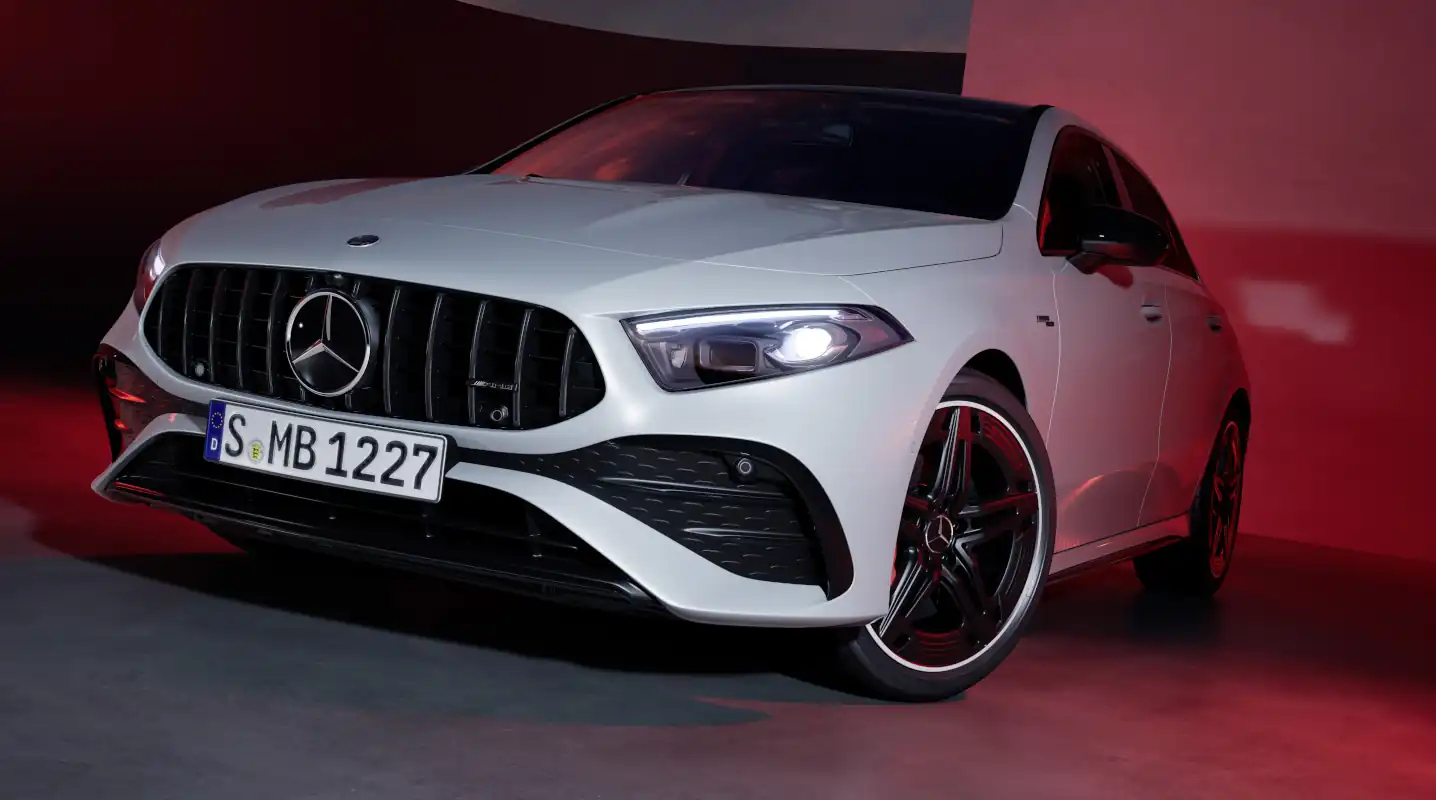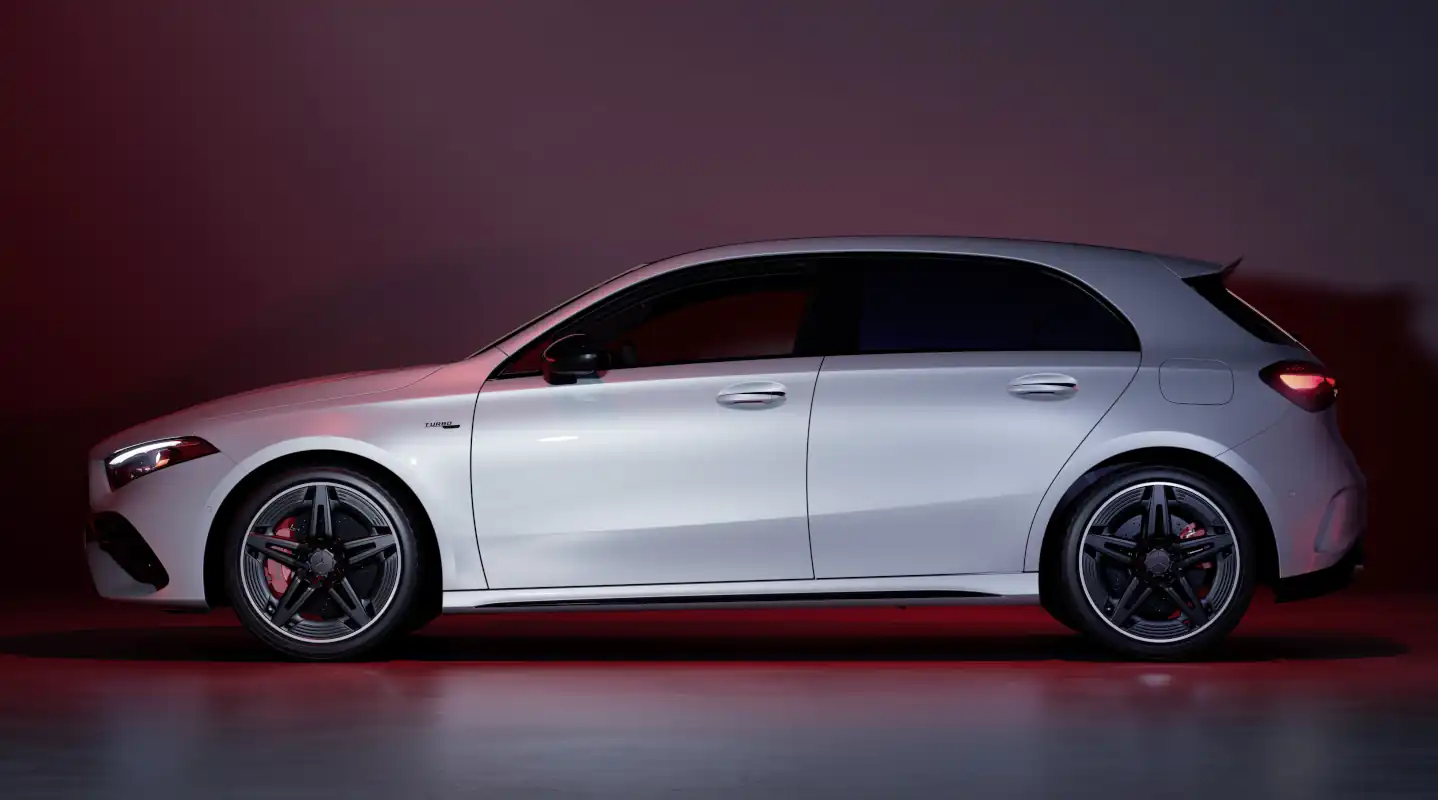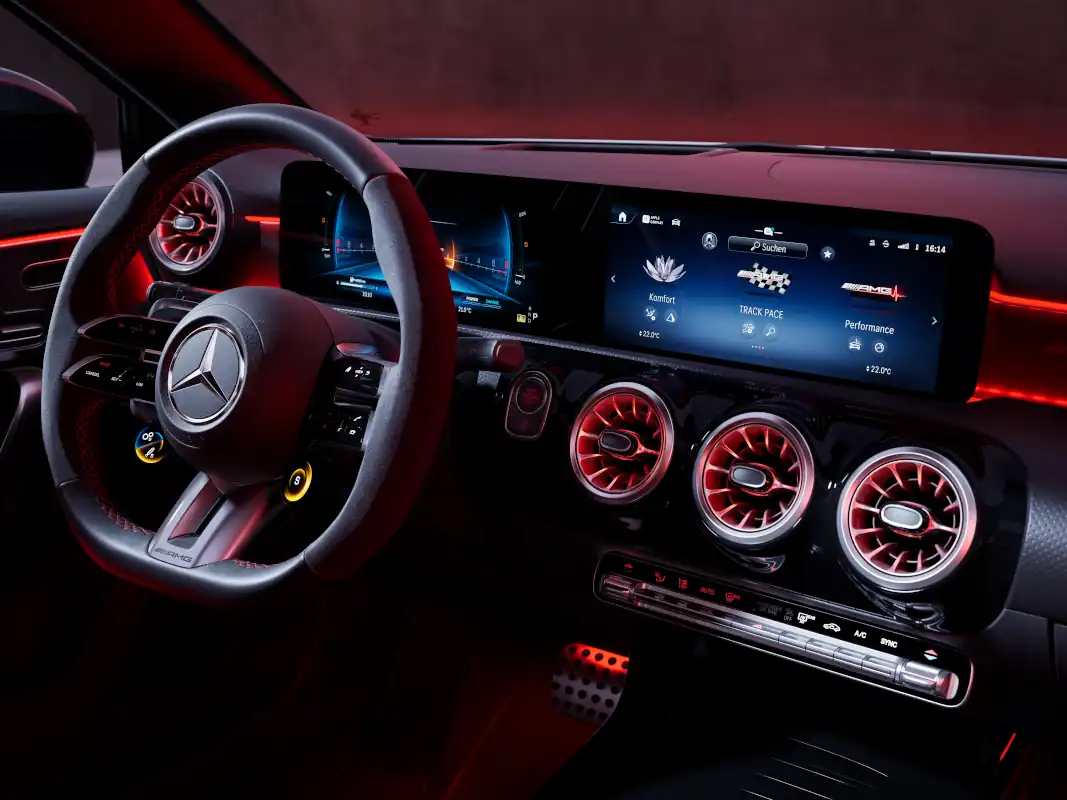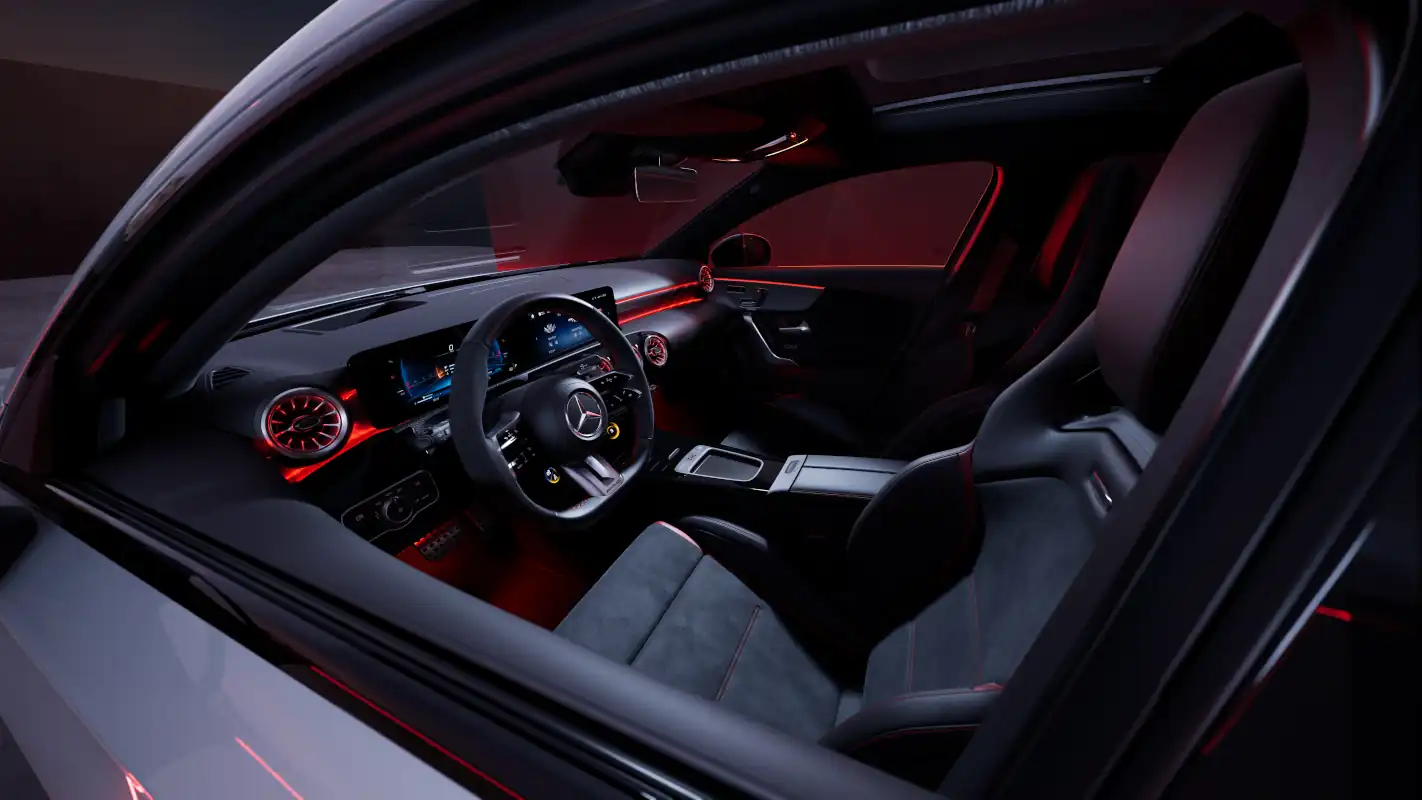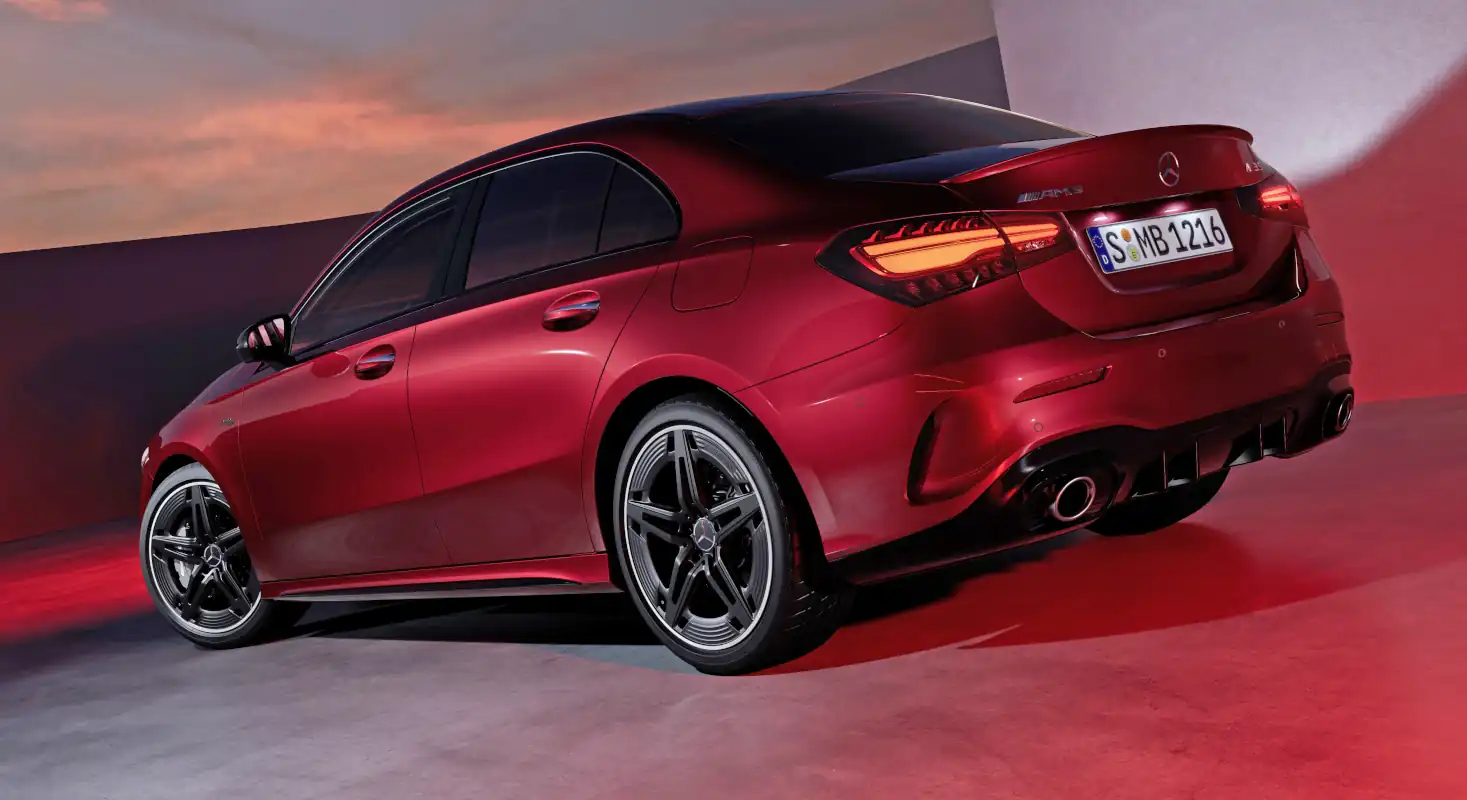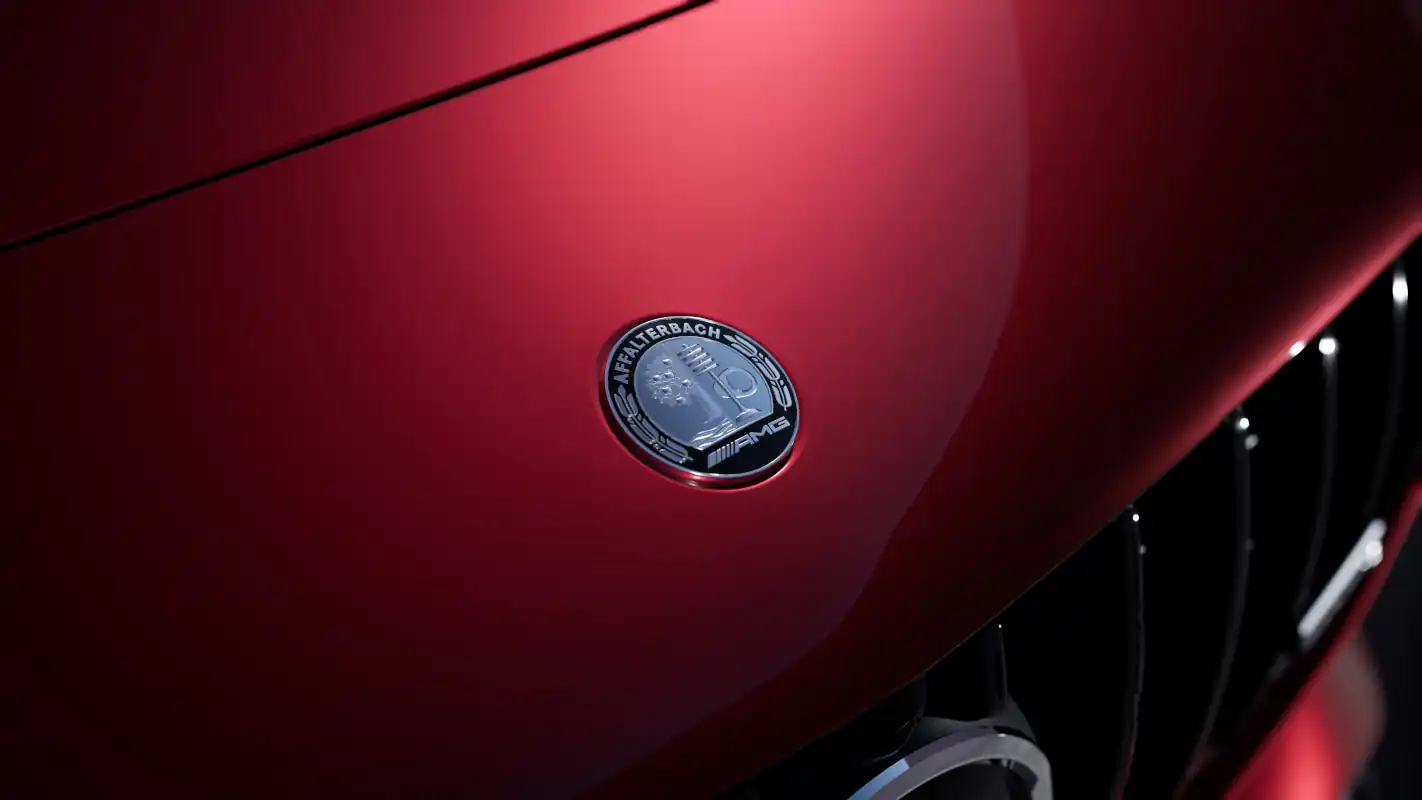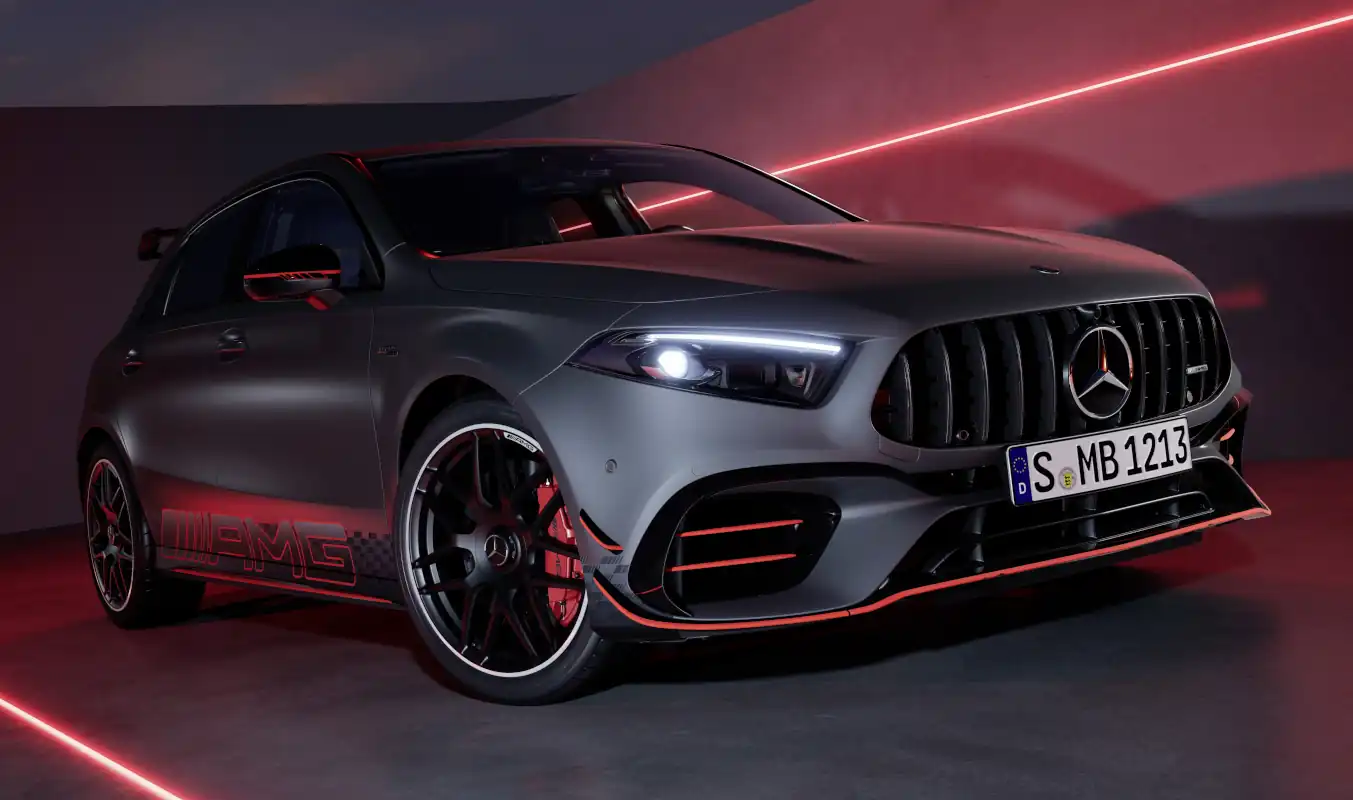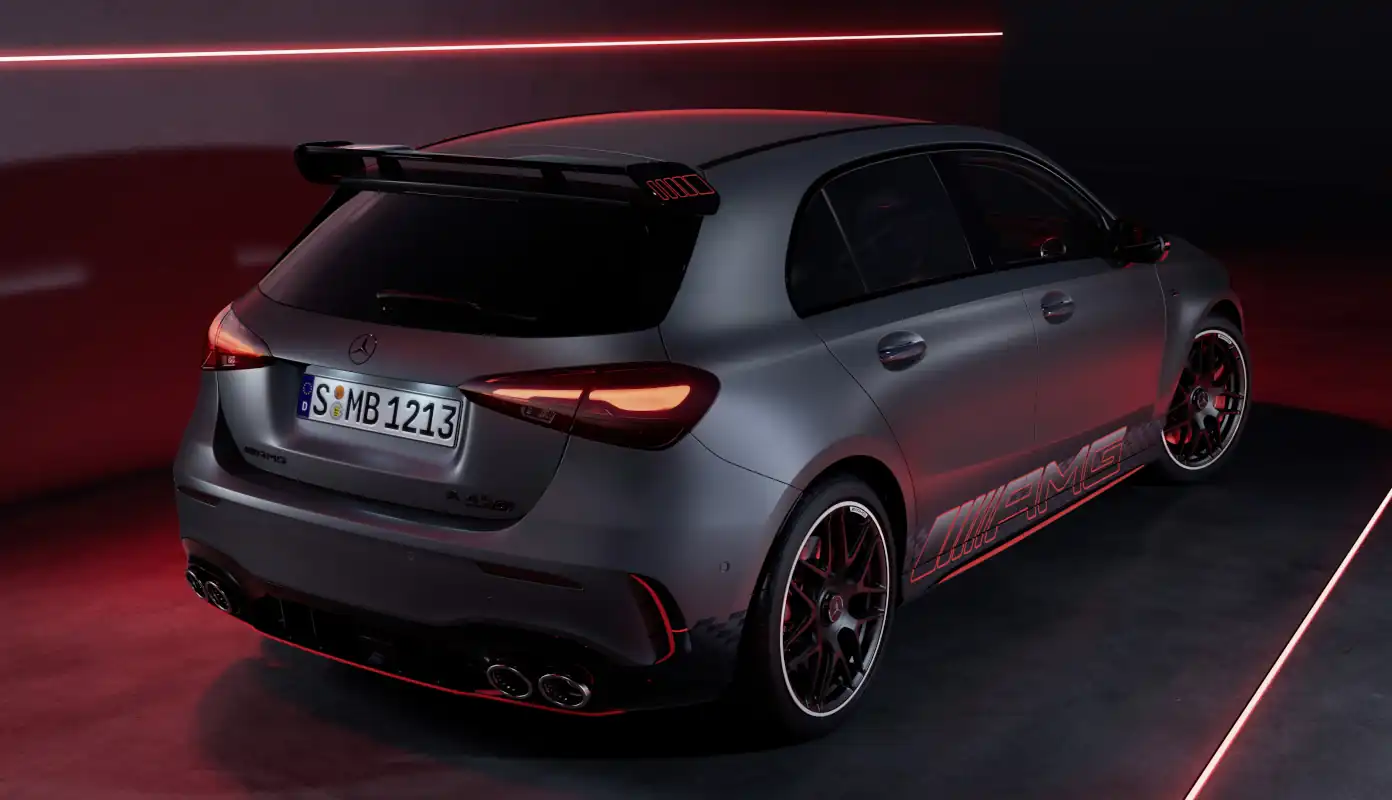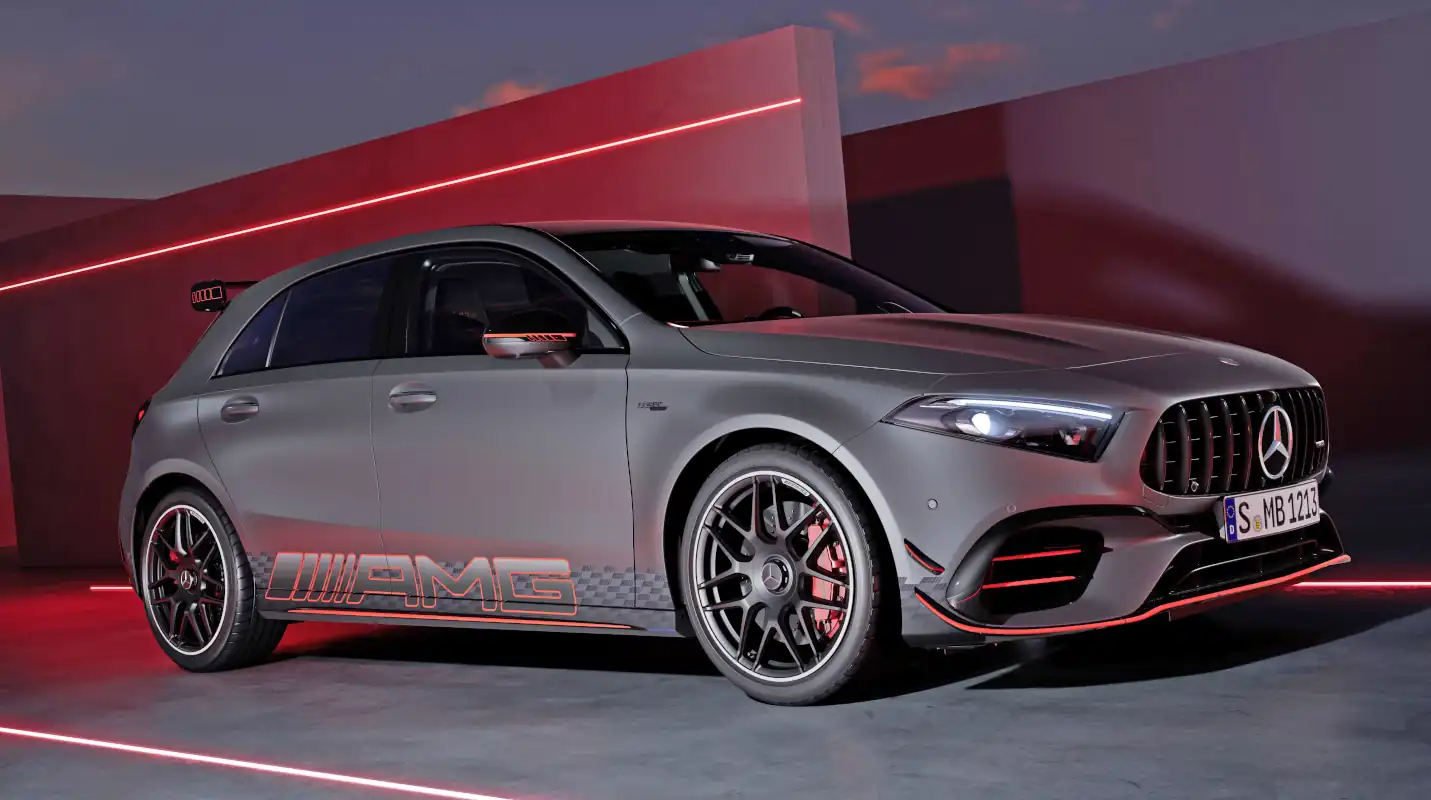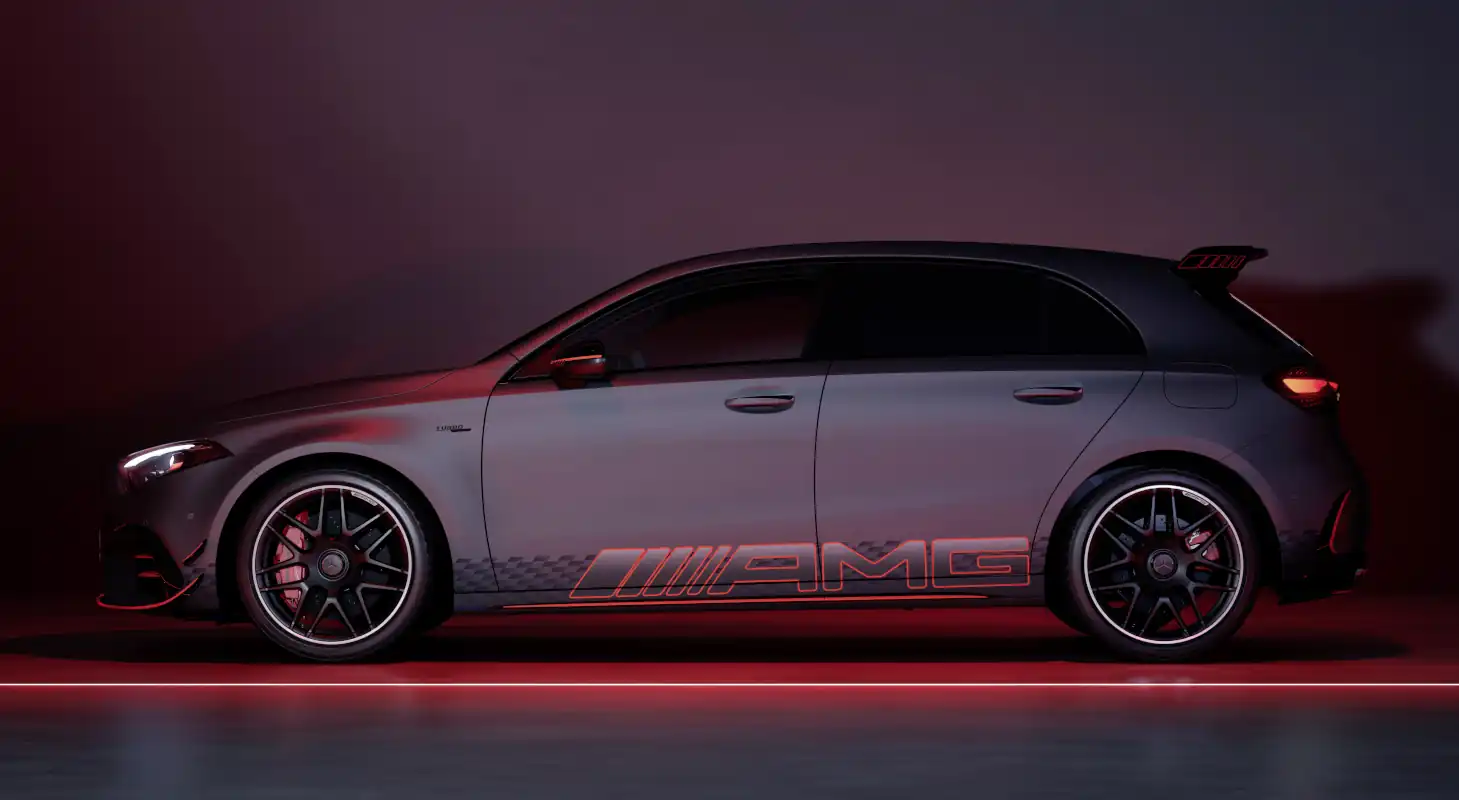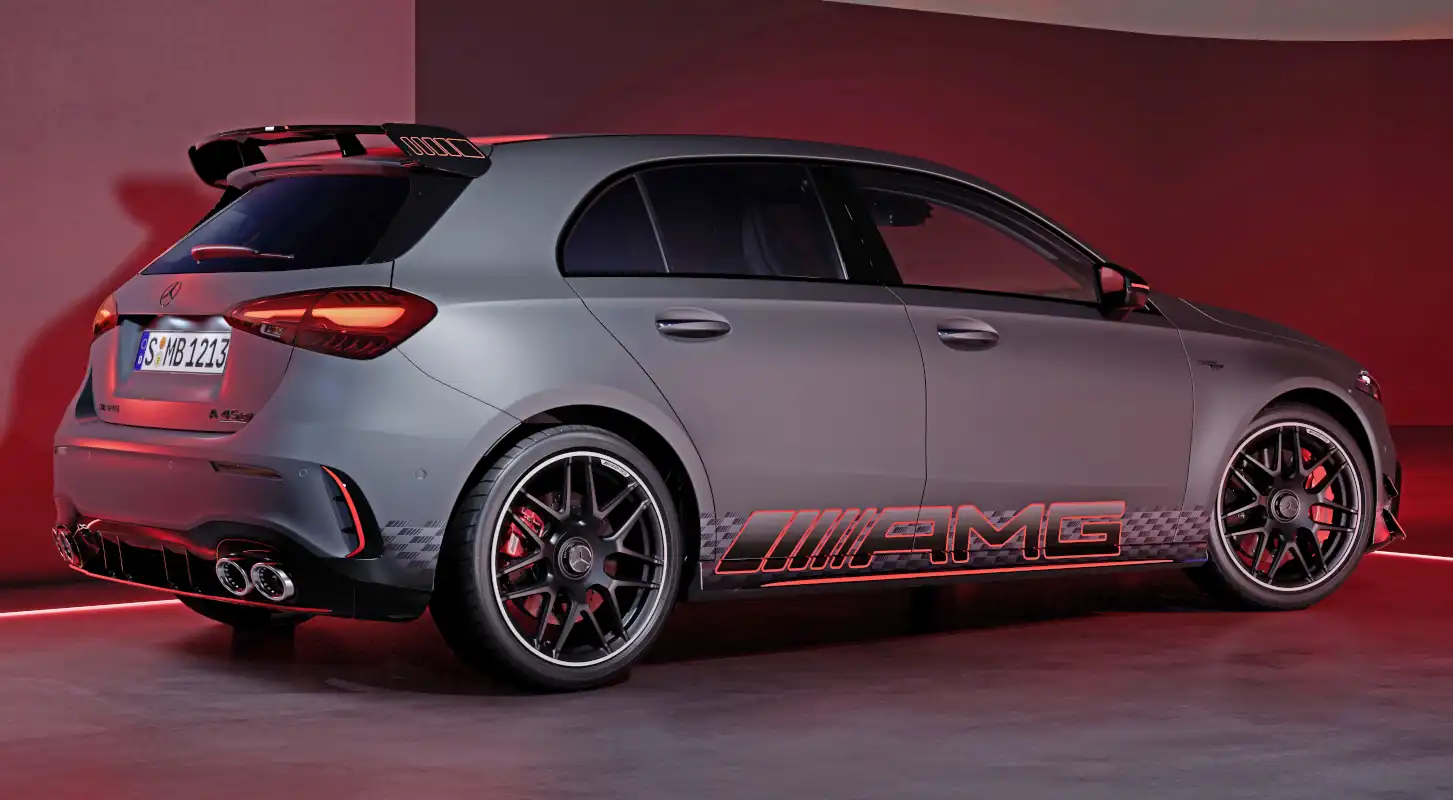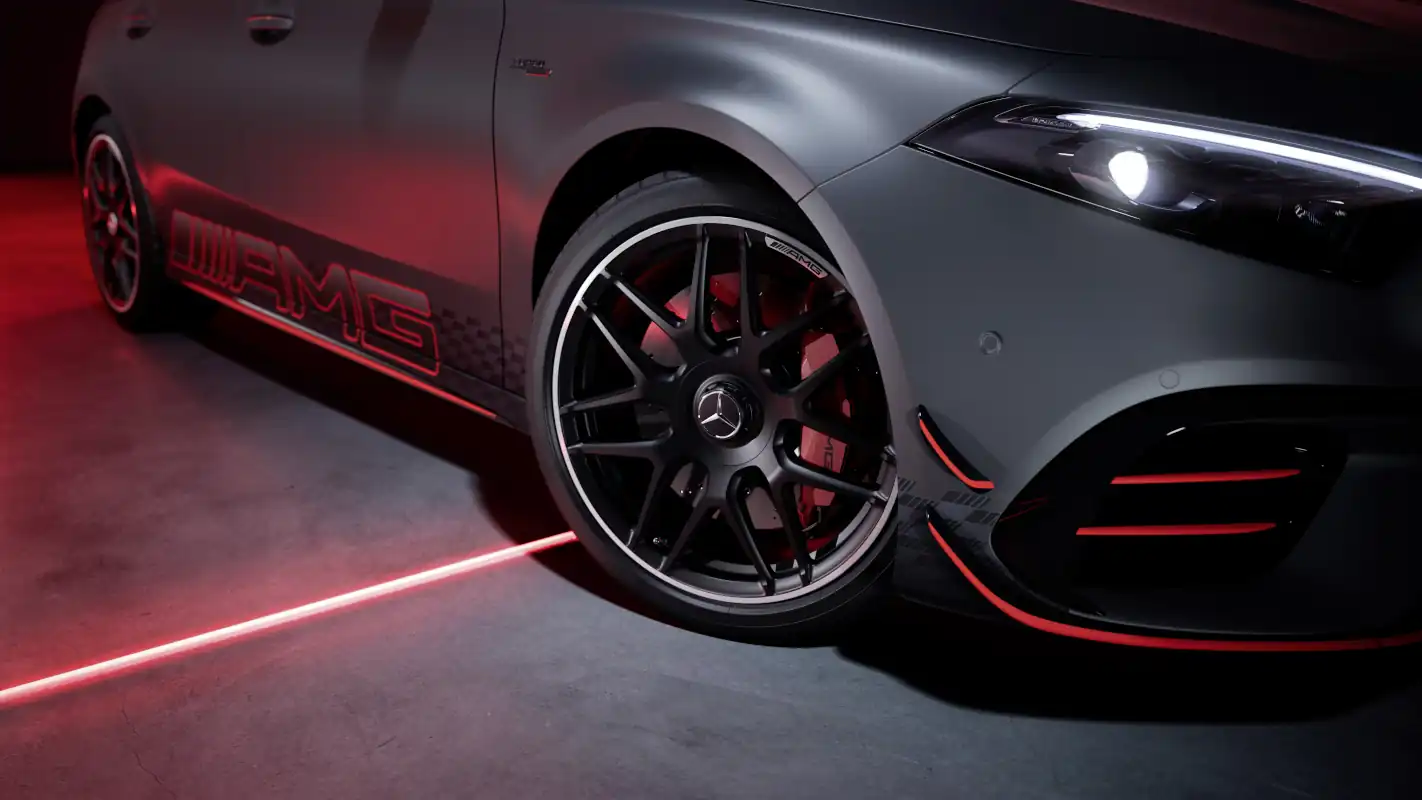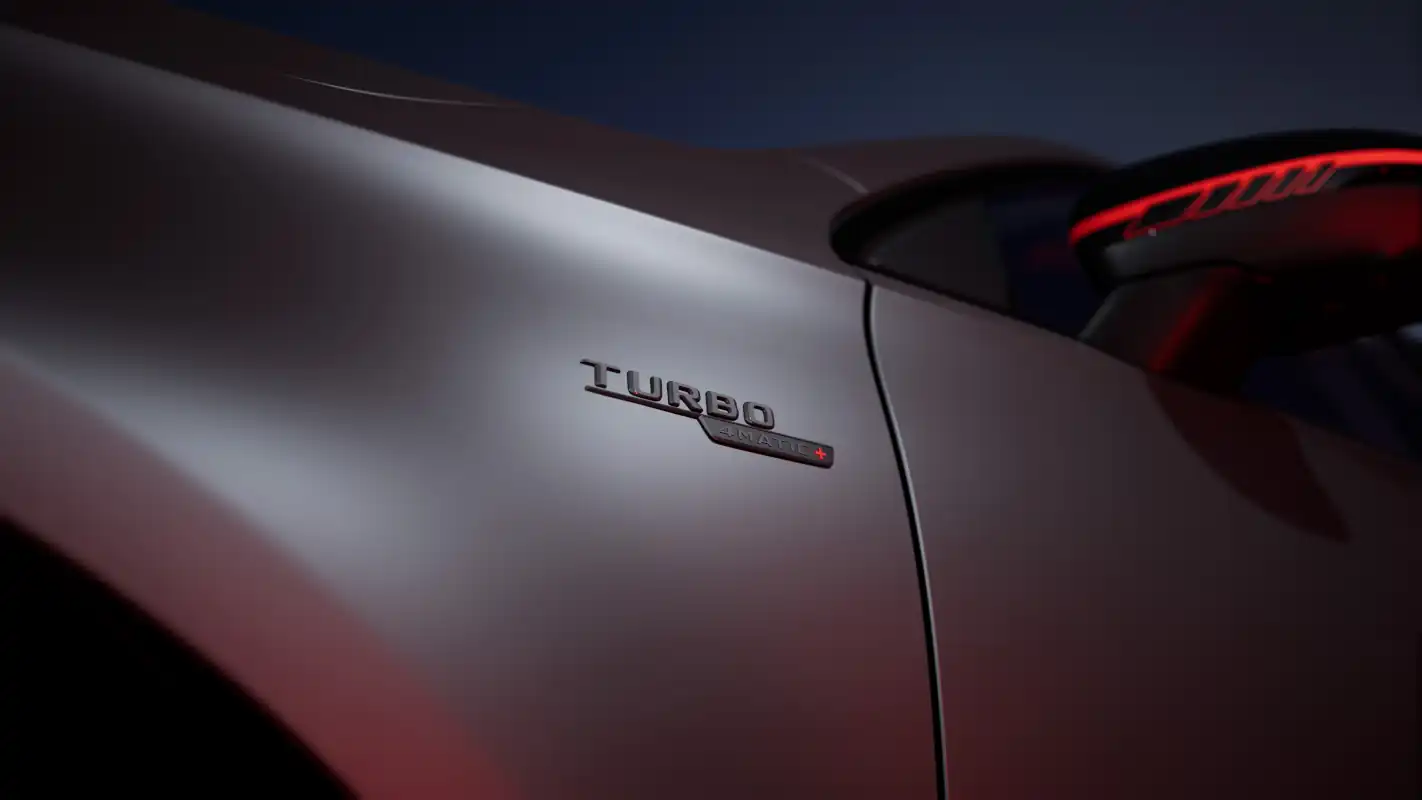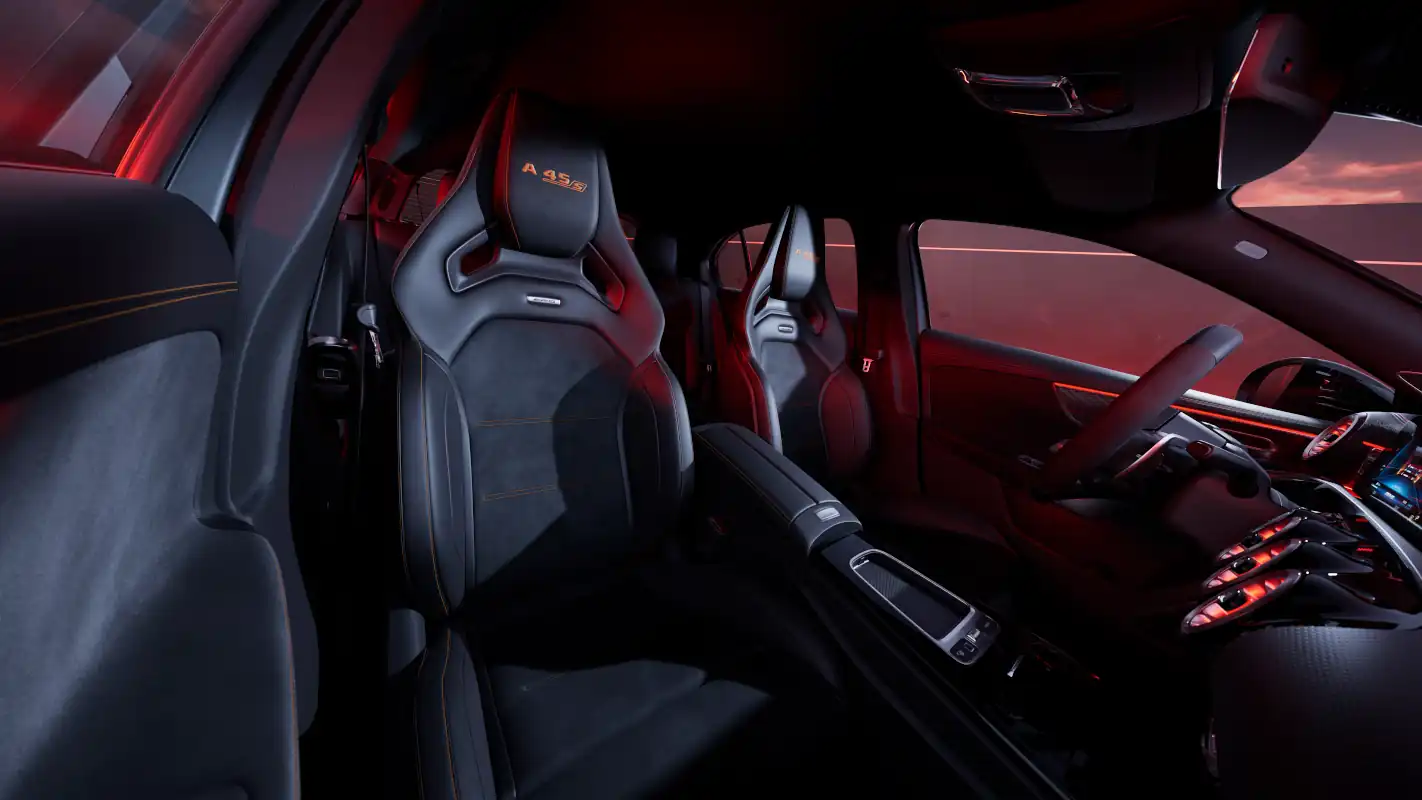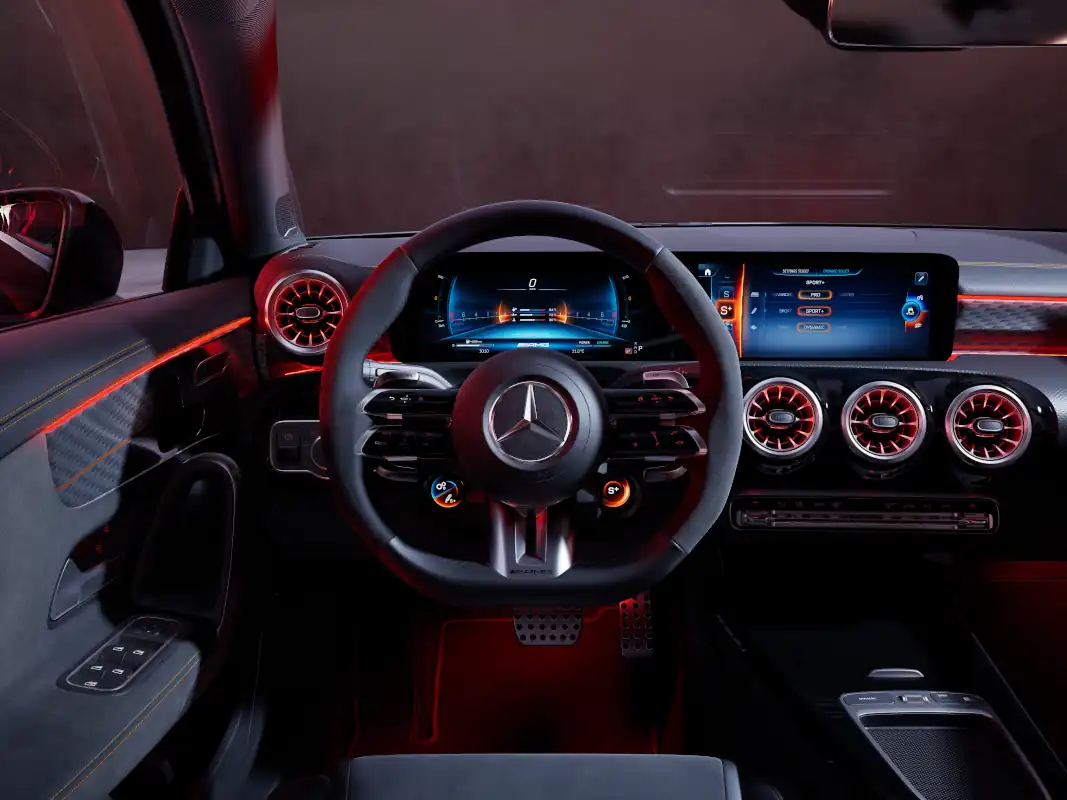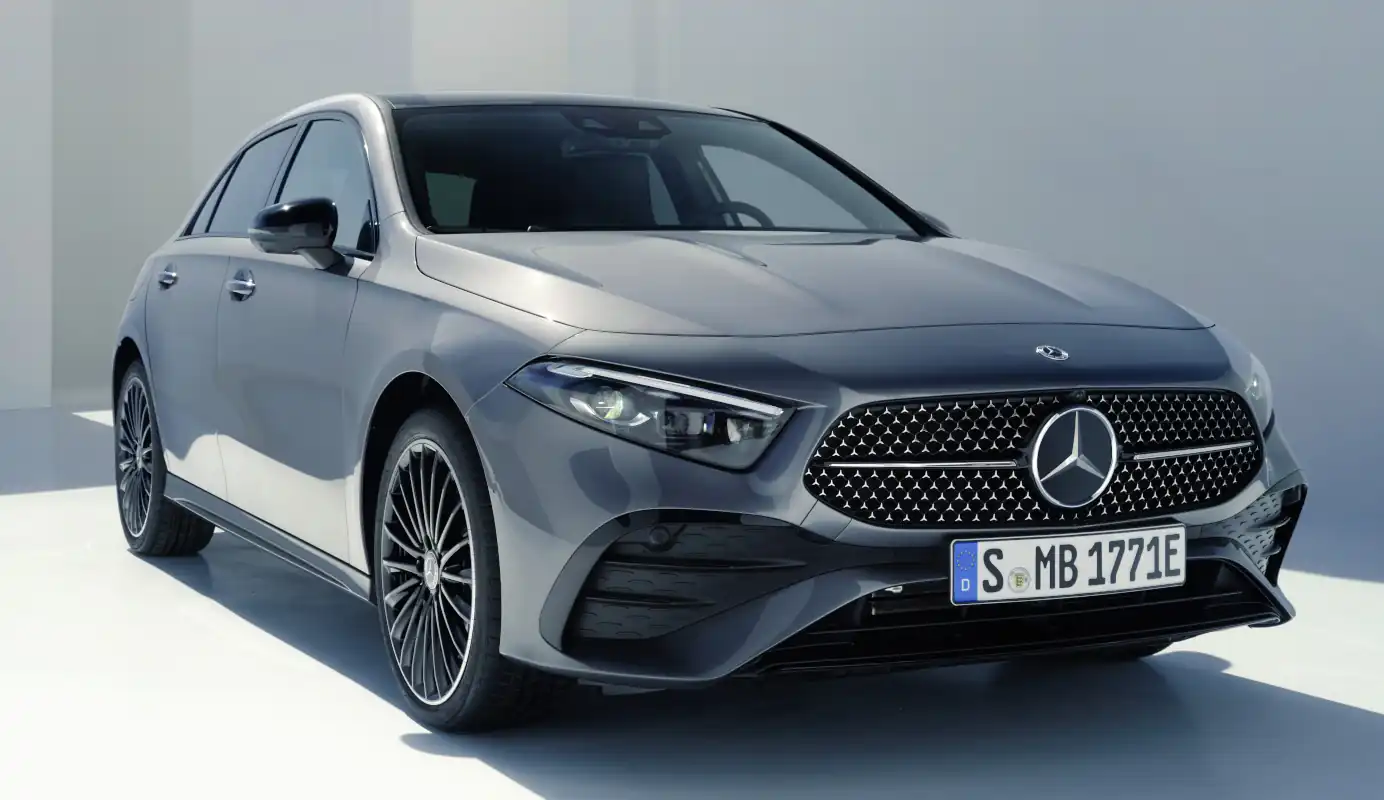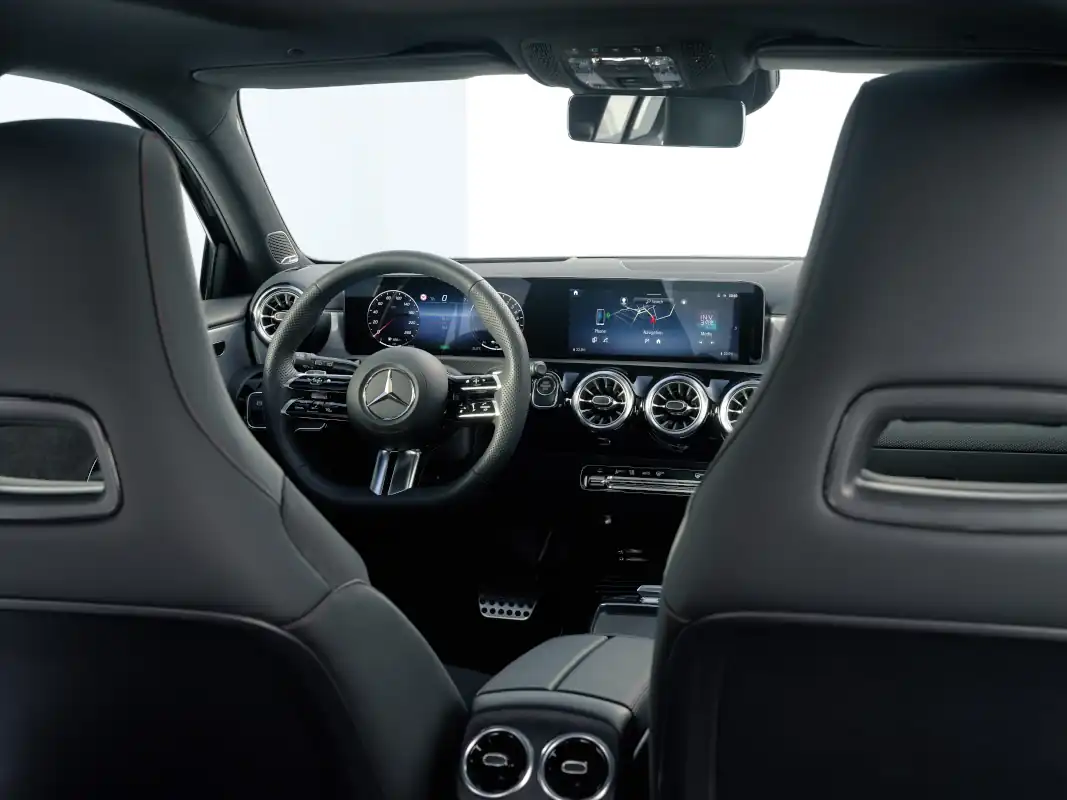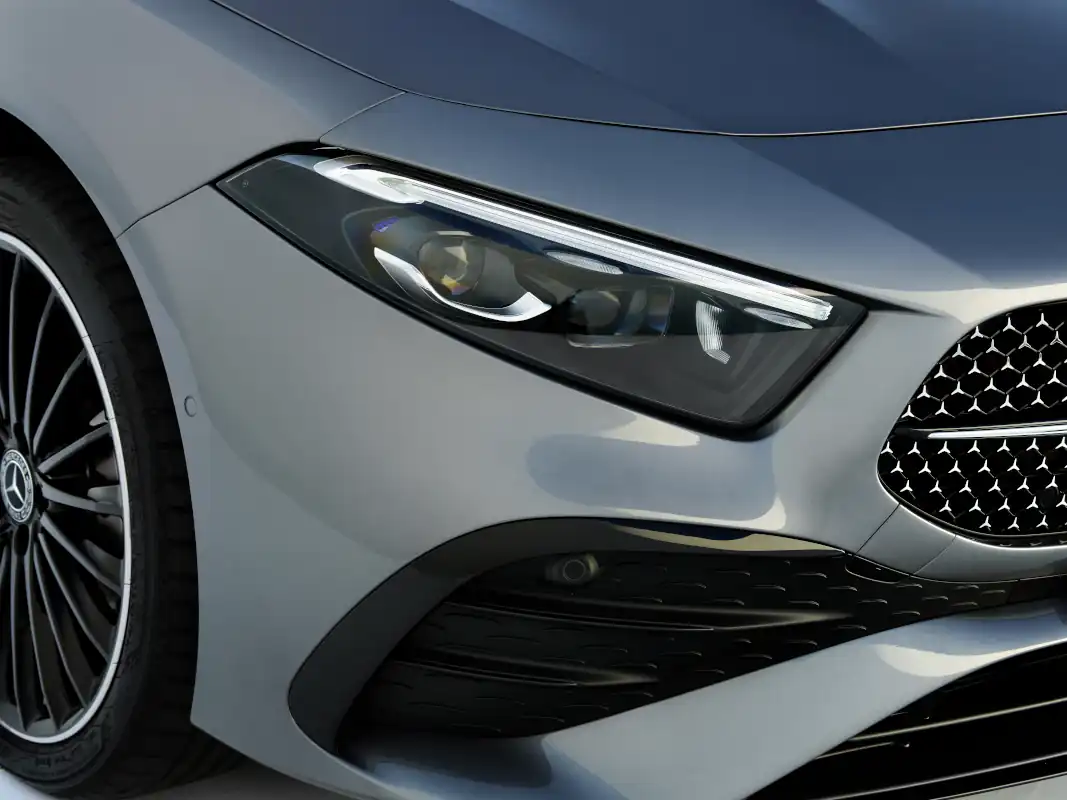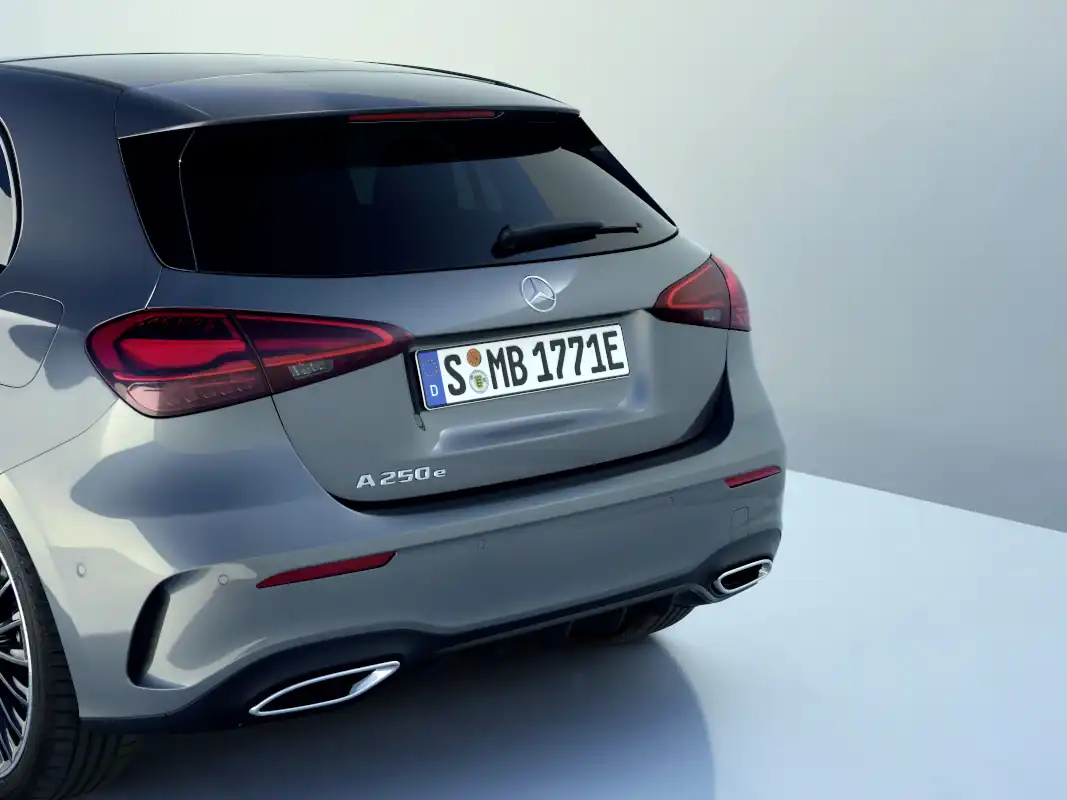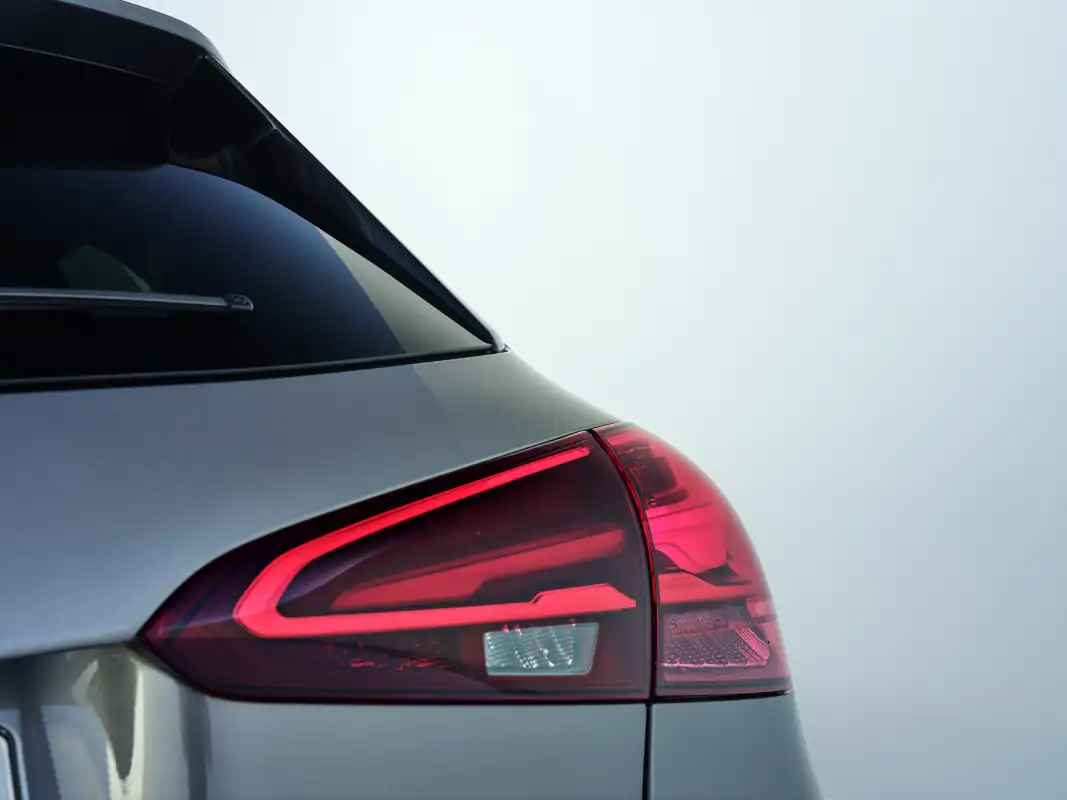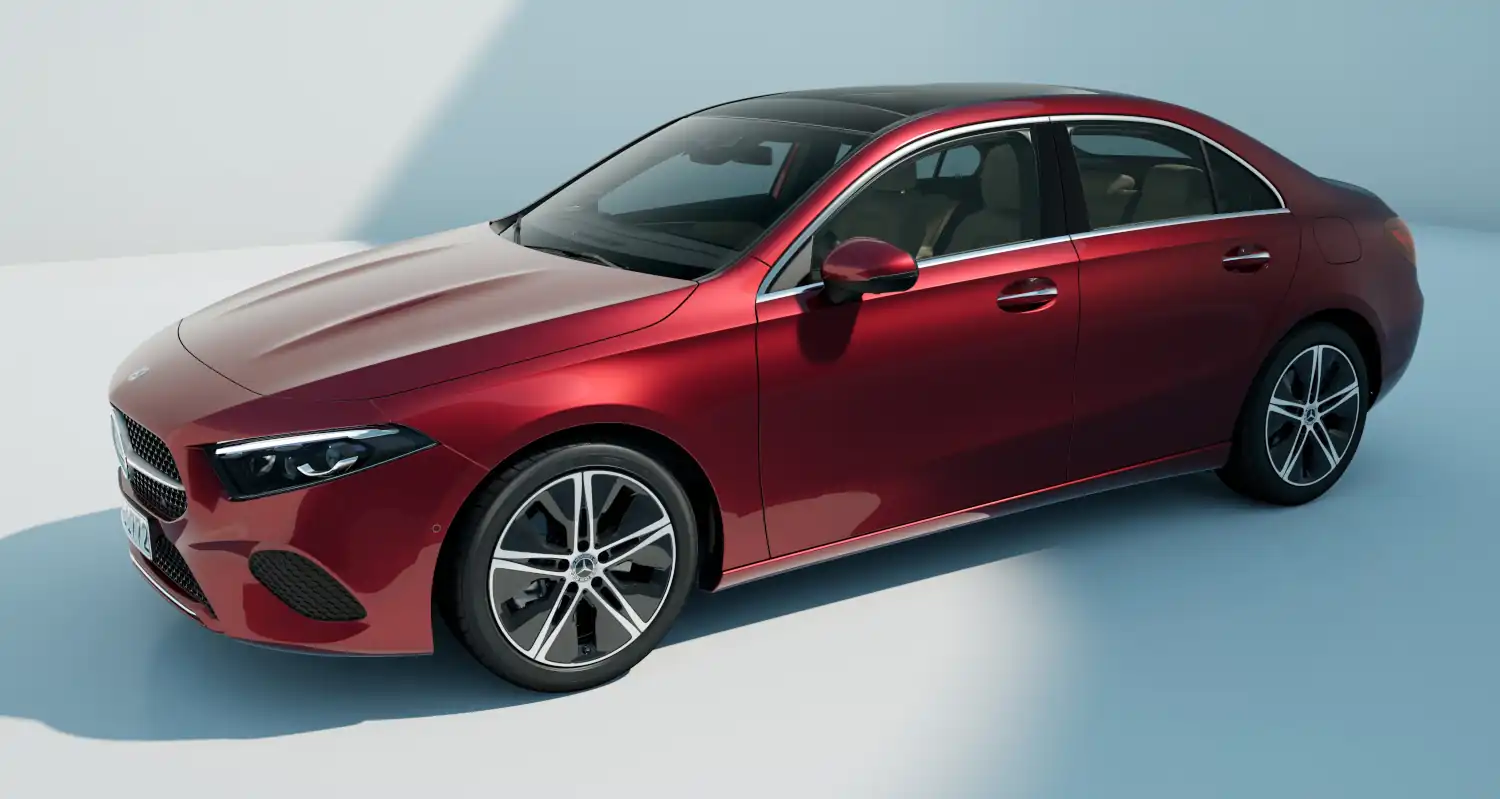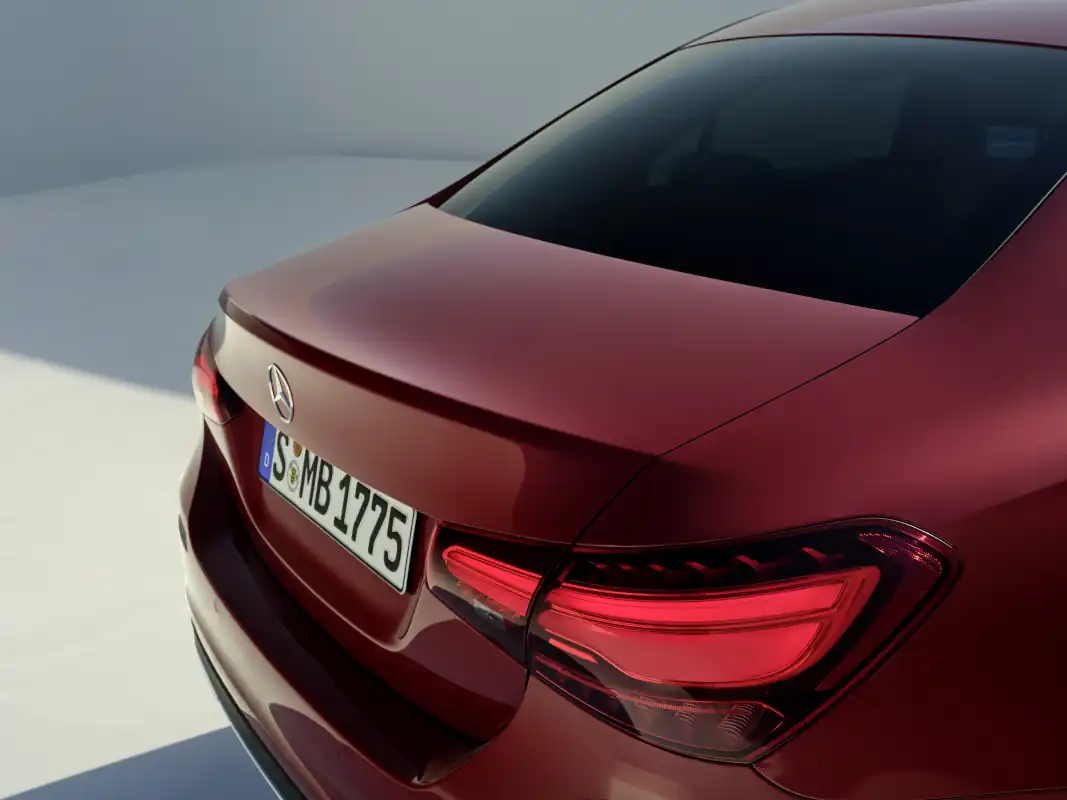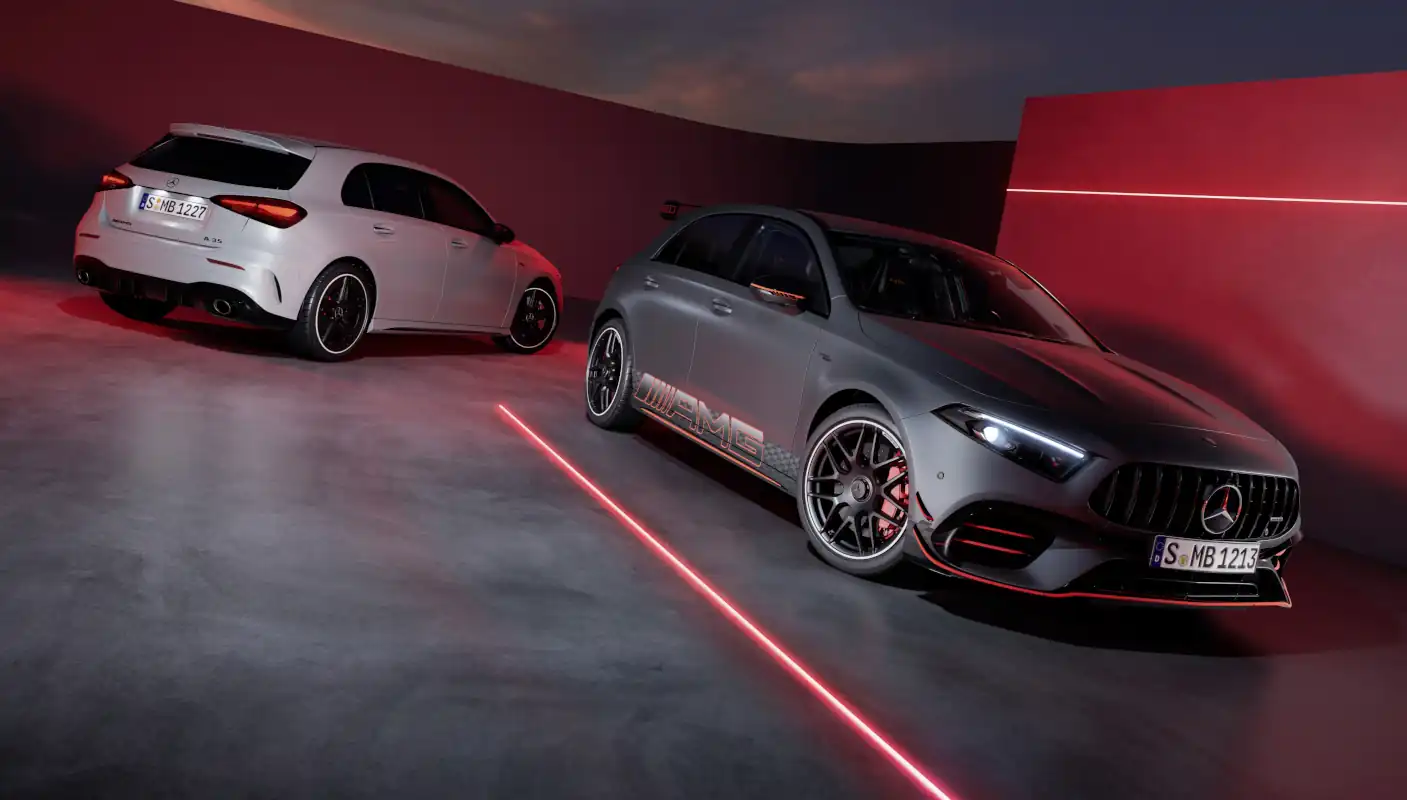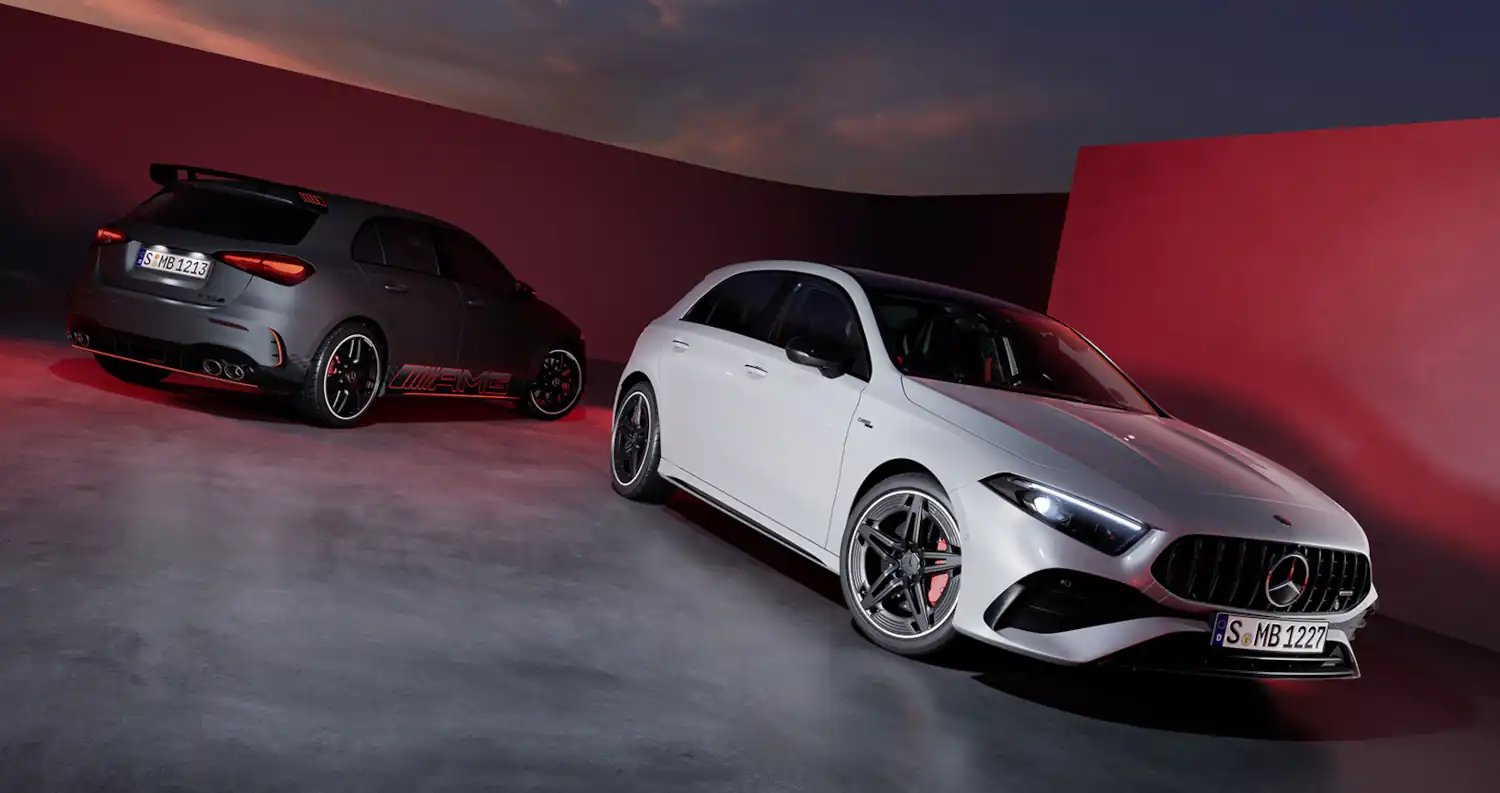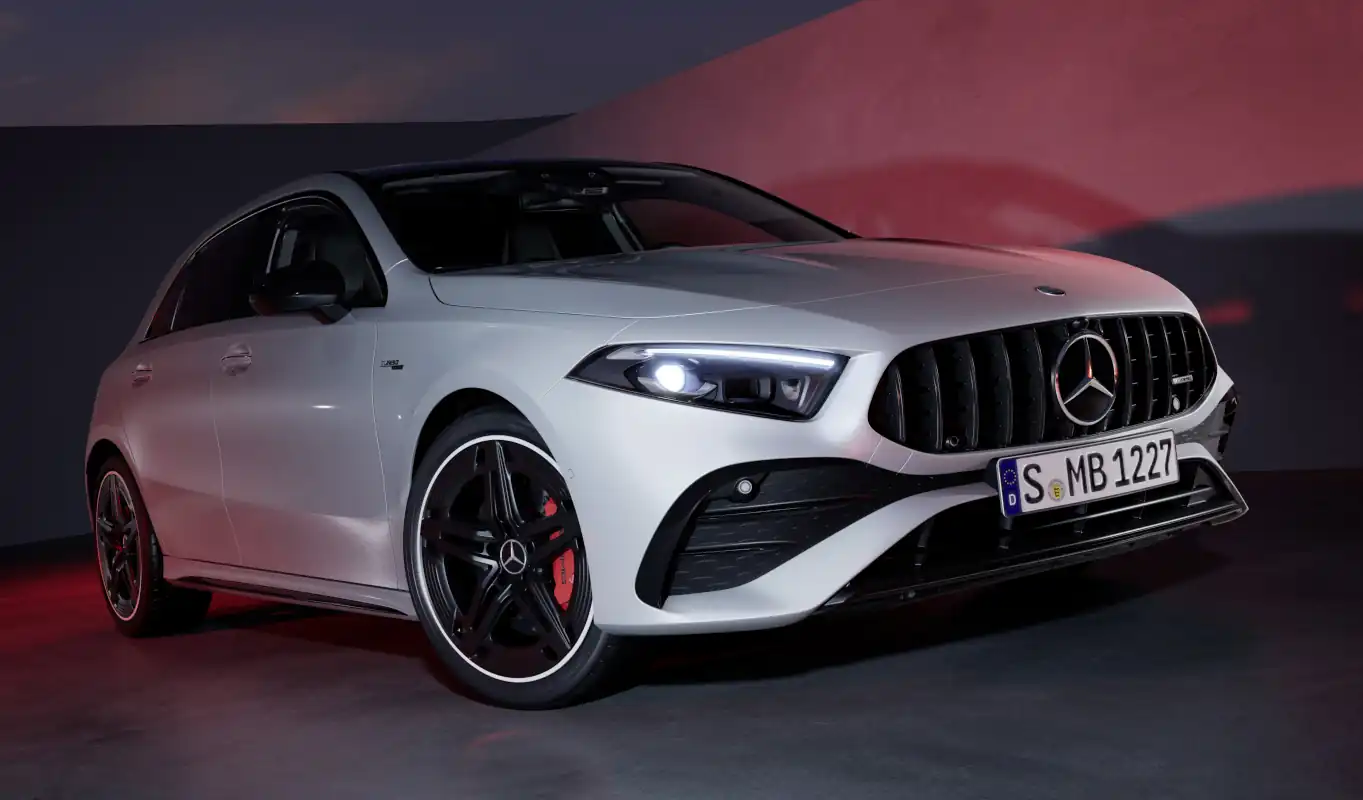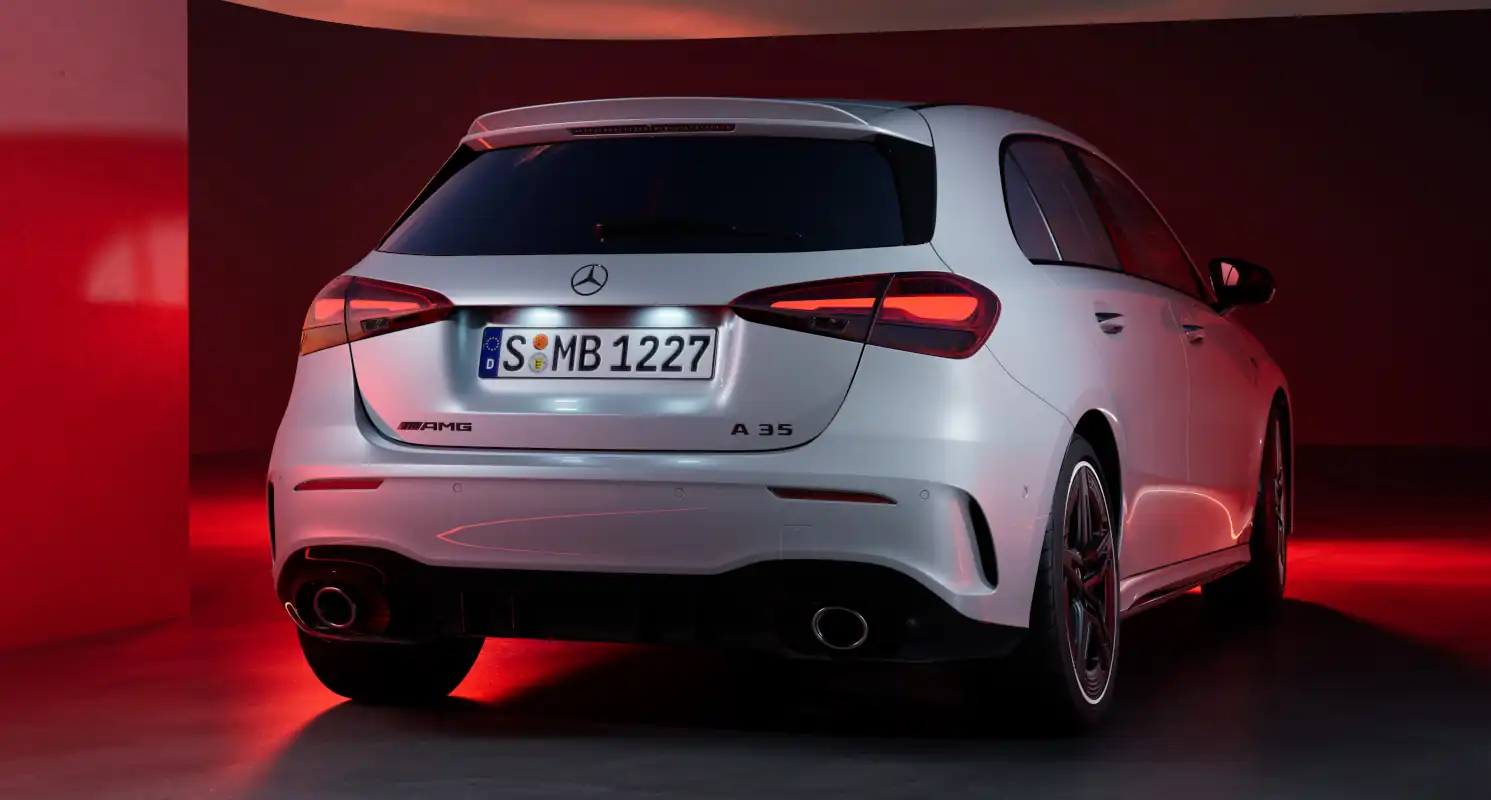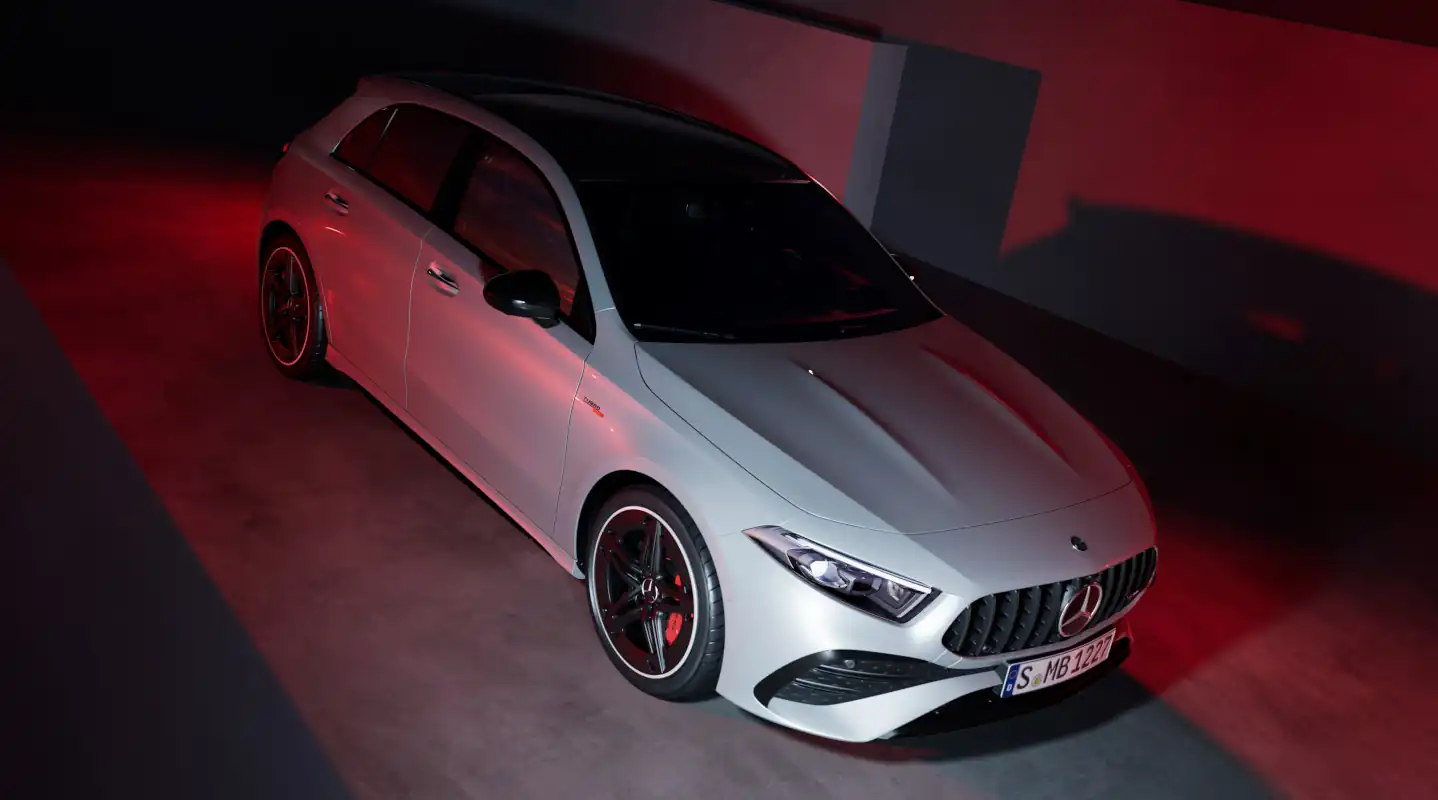
Even from the front, the new A‑Class conveys power and dynamism. The front view is dominated by the forward-sloping bonnet with its two power bulges and steep ‘shark nose’, the redesigned radiator grille with star pattern and the flat headlamps, available as an option in an LED variant. The sporty character is underlined by externally flush wheels with four additional rim designs in sizes up to 19 inches, including optional high-gloss black painted light-alloy wheels in multi-spoke design and with a high-gloss rim flange for the AMG Line. The new rear diffuser and the standard LED rear lights ensure a fascinating and emotionally appealing appearance by both day and night. The high-class exterior is perfectly complemented by an attractive choice of exterior paintwork: A variety of non-metallic/metallic and MANUFAKTUR paint finishes are available.
Individual interior with high-tech: Exclusiveness is also reflected in the interior of the new A‑Class. The absolute highlight is the standard freestanding dual-screen display with a 7‑inch and the larger 10.25‑inch display taking centre stage. Optional are two 10.25‑inch displays that seem to float with their wide-screen look. The internal architecture, which is unique in this class, gives rise to a very special lighting ambience that is perhaps reminiscent of the illumination of a futuristic building at night. The three round turbine-look air vents, so typical of Mercedes‑Benz, are a homage to the world of aviation. The revised steering wheel of the current steering wheel generation, in nappa leather as standard, is compact and matches the high-tech character of the redesigned centre console.
Inside, too, the model range covers all individualisation wishes: even in the base variant of the new A‑Class, Mercedes‑Benz offers a high-quality comfort seat whose new, three-dimensionally embossed ARTICO upholstery further emphasises the sportiness of the vehicle. The Progressive trim level offers three different interior colours: black, a luxurious-looking beige and the new, zeitgeisty sage grey. A new, dark carbon-fibre look trim element further enhances both the instrument panel and the doors in these models. The AMG Line is designed for performance and features bright brushed aluminium trim and red contrasting topstitching in the ARTICO/MICROCUT seats.
In its Ambition 2039, Mercedes-Benz has set itself the goal of launching a CO2-neutral fleet of new passenger cars and vans from 2039 across the entire value chain and life cycle. The aim is to at least halve CO2 emissions per passenger car in the new vehicle fleet over the entire life cycle compared to 2020 by the end of this decade. One measure is the use of recycled materials. For this reason, the composition of all materials to be used was also reviewed during the design of the new B-Class and possibilities for more sustainable alternatives examined. The comfort seats feature fabrics in the centre section that are made from 100 percent recycled material. In the case of ARTICO/MICROCUT seats, this proportion is 65 percent in the surface of the seat and 85 percent in the material underneath.
Significantly upgraded equipment: Even in its standard specification, the new A-Class offers many included features, for example a reversing camera, the USB Package or the steering wheel in nappa leather. From the Progressive trim level upwards, customers can also look forward to LED headlamps, a seat with lumbar support, the Parking Package and the Mirror Package as standard.
Overall, Mercedes has again significantly simplified the offer logic for the equipment packages in order to reduce the time-consuming selection of many individual options. Functional features that are frequently ordered together are now bundled into equipment packages on the basis of actual buyer behaviour. Further functional options are available in addition. Where design options such as paint finish, upholstery, trim and wheels are concerned, customers can still configure their vehicles individually as before.
More digital, smarter, safer: In the new A-Class, both hardware and software have taken a major leap forward: the latest generation of MBUX is intuitive to operate and capable of learning. The driver and central displays create a holistic, aesthetic experience and can be customised as desired with the help of the newly designed display styles (Classic with all relevant driver information, Sporty with the dynamic rev counter, Discreet with reduced content), three modes (Navigation, Assistance, Service) and seven colour worlds. The central display offers all previous functions such as navigation, media, phone, vehicle, etc. and can be operated directly and conveniently as a touchscreen.
The telematics system has been revised and impresses with its new design and improved performance. Another new feature is the integration of a fingerprint sensor (expected to be available from the 1st quarter of 2023) for the identification and authorisation of the driver. Of course, connectivity with smartphones is possible via Apple Carplay or Android Auto Wireless, and for further connectivity an additional USB-C port has been added and the USB charging capacity increased once again.
With the activation of online services in the Mercedes me App[1] the Hey Mercedes voice assistant in the new A-Class is now even more capable of dialogue and learning. For example, certain actions can also be triggered without the activation term “Hey Mercedes”. The MBUX voice assistant can also explain vehicle functions and provides support when you want to connect your smartphone via Bluetooth or search for the first-aid kit.
Initially available exclusively in Germany, the new audio travel guide “Tourguide”, part of the “MBUX Voice Assistant” from Mercedes me, adds an exciting feature to the previous travel information functions. In response to the voice command “Hey Mercedes, start Tourguide”, the MBUX infotainment system reads out extensive information about points of interest along the route and reacts to the approximately 3400 brown tourist information signs along the German motorways, among other things.
The new A-Class has also been given an update in terms of safety assistance. With the upgrade of the Driver Assistance Package, for example, the control of the Lane Keeping Assist is much more comfortable by using the Active Steering Control. The next generation of the Parking Package supports longitudinal parking and offers, among other things, 360-degree visualisation for camera-assisted parking using 3D images.
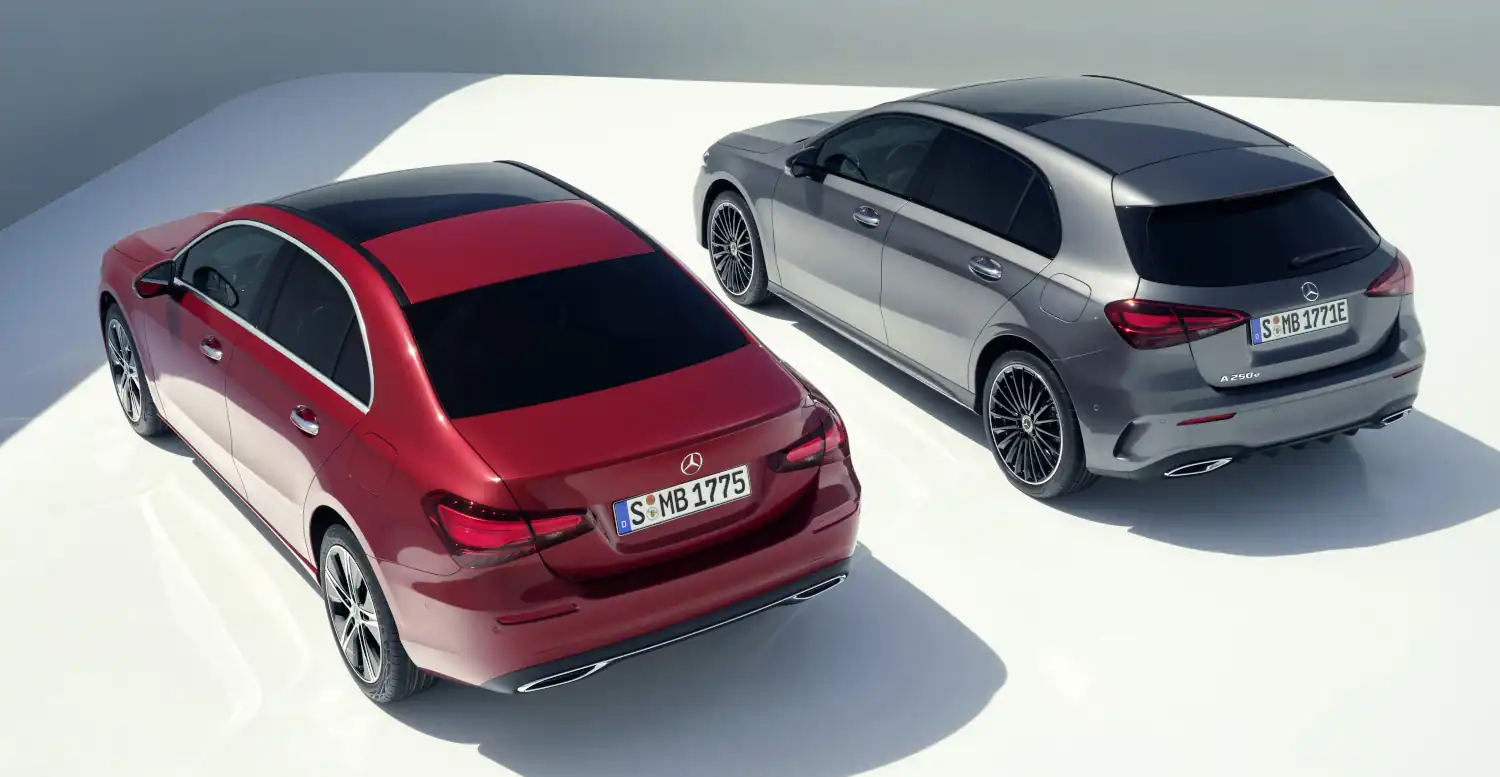
Electrified and powerful drives: The new A-Class has also received an update with respect to its engines. The petrol engine range has been electrified throughout and includes four-cylinder units with a 7- or 8-speed DCT automatic as standard. As mild hybrids, these are equipped with an additional 48-volt electrical system that supports agility when starting off with 10 kW more power.
The new belt-driven starter-generator (RSG) noticeably improves the comfort and experience for customers of the new A-Class. During starting operations, for example, the RSG ensures a lower-vibration and quieter start than conventional starters. In addition, it allows ‘sailing’ with the combustion engine switched off during steady cruising. During braking and overrun, the RSG recuperates and thus supplies the 12-volt on-board network and the 48-volt battery. The energy thus generated can be used during acceleration processes to support the combustion engine. Through the differentiated evaluation of the various driving phases, the ECO Score 3.0, newly introduced for some engines, also motivates the driver to drive in a more fuel-efficient way.
More power for plug-in hybrids: The new A-Class takes another big step with the plug-in hybrid drives (Mercedes-Benz A 250 e Hatchback: Fuel consumption combined, weighted (WLTP) 1.1-0.8 l/100 km, electrical consumption combined, weighted (WLTP) 17.0‑15.0 kWh/100km, CO2– emissions combined, weighted (WLTP) 25‑18g/km; Mercedes-Benz A 250 e Saloon: Fuel consumption combined, weighted (WLTP) 1.0‑0.8 l/100 km, electrical consumption combined, weighted (WLTP) 16.7‑14.8 kWh/100km, CO2 emissions combined, weighted (WLTP) 24‑17 g/km) [2]. The high-voltage battery has been improved once again, so that the higher usable energy content leads to an increase in the electric range. The power of the electric motor has been increased by 5 kW and now reaches a driveline power of 80 kW. As far as charging is concerned, there are still three options available: in addition to the 3.7 kW standard, the improved battery can now also be charged with alternating current and up to 11 kW, instead of only 7.4 kW as before. The new A-Class also continues to offer the option of charging the battery with direct current and up to 22 kW. A DC charge from 10% to 80% takes around 25 minutes, providing a versatile charging experience suitable for everyday use.
The engines at a glance:
| A 250 e Hatchback | A 250 e Saloon | ||
| Displacement | cc | 1332 | 1332 |
| Rated output, petrol engine | kW/hp | 120/163 | 120/163 |
| at | rpm | 5500 | 5500 |
| Rated torque | Nm | 270 | 270 |
| Rated output, electric motor | kW/hp | 80/109 | 80/109 |
| Rated torque, electric motor | Nm | 300 | 300 |
| System output | kW/hp | 160/218 | 160/218 |
| System torque | Nm | 450 | 450 |
| Rated battery capacity | kWh | 15.6 | 15.6 |
| Combined consumption, weighted (WLTP)2 | l/100 km | 1.1 – 0.8 | 1.0 – 0.8 |
| Combined CO2 emissions, weighted (WLTP)2 | g/km | 25.0 – 18.0 | 24.0 – 17.0 |
| Combined power consumption, weighted (WLTP)2 | kWh/100 km | 17.0 – 15.0 | 16.7 – 14.8 |
| All-electric range (combined EAER) (WLTP)2 | km | 70.0 – 81.0 | 72.0 – 82.0 |
| Acceleration 0-100 km/h | s | 7.4 | 7.5 |
| Top speed | km/h | 225 | 230 |
| A 180 Hatchback | A 200 Hatchback | A 220 4MATIC Hatchback | A 250 4MATIC Hatchback | ||
| Displacement | cc | 1332 | 1332 | 1991 | 1991 |
| Rated output | kW/hp | 100/136 | 120/163 | 140/190 | 165/224 |
| at | rpm | 5500 | 5500 | 5500 | 5500 |
| Add. output (boost effect) | kW/hp | 10/14 | 10/14 | 10/14 | 10/14 |
| Rated torque | Nm | 230 | 270 | 300 | 350 |
| Fuel consumption combined (WLTP)2 | l/100 km | 6.4 – 5.8 | 6.4 – 5.8 | 7.5 – 6.9 | 7.5 – 6.9 |
| Combined CO2 emissions (WLTP) 2 | g/km | 145.0 – 133.0 | 145.0 – 133.0 | 170.0 – 157.0 | 170.0 – 157.0 |
| Acceleration 0-100 km/h | s | 9.2 | 8.2 | 7.1 | 6.3 |
| Top speed | km/h | 215 | 225 | 235 | 250 |
| A 180 d Hatchback | A 200 d Hatchback | A 220 d Hatchback | ||
| Displacement | cc | 1950 | 1950 | 1950 |
| Rated output | kW/hp | 85/116 | 110/150 | 140/190 |
| at | rpm | 3.400 | 3.400 | 3800 |
| Rated torque | Nm | 280 | 320 | 400 |
| Fuel consumption combined (WLTP)2 | l/100 km | 5.5 – 5.0 | 5.4 – 4.9 | 5.5 – 5.0 |
| Combined CO2 emissions (WLTP) 2 | g/km | 145.0 – 132.0 | 143.0 – 128.0 | 144.0 – 131.0 |
| Acceleration 0-100 km/h | s | 9.7 | 8.3 | 7.2 |
| Top speed | km/h | 202 | 220 | 235 |
| A 180 Saloon | A 200 Saloon | A 220 4MATIC Saloon | A 250 4MATIC Saloon | ||
| Displacement | cc | 1332 | 1332 | 1991 | 1991 |
| Rated output | kW/hp | 100/136 | 120/163 | 140/190 | 165/224 |
| at | rpm | 5500 | 5500 | 5500 | 5500 |
| Add. output (boost effect) | kW/hp | 10/14 | 10/14 | 10/14 | 10/14 |
| Rated torque | Nm | 230 | 270 | 300 | 350 |
| Fuel consumption combined (WLTP)2 | l/100 km | 6.3 – 5.7 | 6.3 – 5.7 | 7.4 – 6.8 | 7.4 – 6.8 |
| Combined CO2 emissions (WLTP)2 | g/km | 143.0 – 130.0 | 143.0 – 130.0 | 167.0 – 154.0 | 168.0 – 155.0 |
| Acceleration 0-100 km/h | s | 9.3 | 8.3 | 7.2 | 6.4 |
| Top speed | km/h | 216 | 230 | 237 | 250 |
| A 180 d Saloon | A 200 d Saloon | A 220 d Saloon | ||
| Displacement | cc | 1950 | 1950 | 1950 |
| Rated output | kW/hp | 85/116 | 110/150 | 140/190 |
| at | rpm | 3.400 | 3.400 | 3800 |
| Rated torque | Nm | 280 | 320 | 400 |
| Fuel consumption combined (WLTP)2 | l/100 km | 5.5 – 5.0 | 5.4 – 4.8 | 5.4 – 5.0 |
| Combined CO2 emissions (WLTP)2 | g/km | 143.0 – 130.0 | 141.0 – 127.0 | 143.0 – 131.0 |
| Acceleration 0-100 km/h | s | 9.9 | 8.4 | 7.3 |
| Top speed | km/h | 206 | 227 | 246 |
[1]To use the Mercedes me connect services, you must create a Mercedes me ID and accept the Terms of Use for the Mercedes me connect services. The services shown and their availability and functionalities depend in particular on the vehicle model, year of manufacture, selected special equipment and country.
[2]The figures shown are the WLTP CO2 figures measured according to Art. 2 No. 3 of Implementing Regulation (EU) 2017/1153. The fuel consumption figures were calculated on the basis of these figures. Power consumption and range were determined on the basis of Commission Regulation (EU) No. 2017/1151.
Mercedes-AMG A-Class
Power and style in a compact format – the new A-Class also makes its debut at Mercedes‑AMG and thus forms the sporty top end of the model series. The top model Mercedes‑AMG A 45 S 4MATIC+ (fuel consumption combined 9.2‑8.8 l/100 km, CO2 emissions combined 208‑200 g/km)2 and especially the Mercedes‑AMG A 35 4MATIC (Hatchback fuel consumption combined 8.6-8.2 l/100 km, CO2 emissions combined 196‑188g/km; Saloon fuel consumption combined 8.5‑8.1 l/100 km, CO2 emissions combined 192‑184g/km)2 benefit from the refresh from Affalterbach. With its revised look, the A 35 moves even closer to the AMG family and is still available as a Hatchback and as a Saloon, while the A 45 S is available as a Hatchback as before.
Exterior: The revised front headlamps, the AMG-specific radiator grille and the new, round badge with the AMG emblem instead of the Mercedes star with a laurel wreath, immediately stand out when looking at the new Mercedes‑AMG A-Class. In addition, a new front apron and the power bulges familiar from the A 45 provide the A 35 with a new, coherent AMG face. The AMG look is underlined by the new wheel design, the rear spoiler lip, revised rear headlamps and the hallmark round exhaust pipes (twin-flow on the Mercedes‑AMG A 45 S 4MATIC+).
Interior: As standard, the new Mercedes-AMG A-Class offers the AMG Performance steering wheel including AMG steering wheel buttons, with which the driver can control AMG-specific features such as the three-stage ESP or AMG Dynamics – without taking their hand off the steering wheel. In addition, the familiar AMG performance seat is now also available in the trendy sage grey colour.
Technology: There is also an engine update in the Mercedes-AMG A-Class. In line with the production models, the Mercedes-AMG A 35 is equipped with a 48-volt auxiliary power supply and belt-driven starter-generator (RSG) and achieves an output of 225 kW/306 hp with a maximum torque of 400 Nm. As a mild hybrid, the RSG supports agility with 10 kW more power at start-up. In addition, an AMG SPEEDSHIFT DCT 8-speed transmission is now on board and the new front radiator facilitates temperature management at the limit.
Infotainment & connectivity: The new Mercedes-AMG A-Class also benefits from the latest MBUX generation: Increased performance, the integration of the fingerprint sensor (expected to be available from the 1st quarter of 2023) for profile authorisation in the central display, more USB charging power and the new hallmark AMG screen design make driving in the new AMG A-Class an interactive pleasure.
AMG Street Style Edition: For the market launch of the new Mercedes-AMG A-Class, a very special version of the Mercedes-AMG A 45 S 4MATIC+ will also be available exclusively and for a limited time: The AMG Street Style Edition impresses with extrovert and exclusive equipment elements. With the base paint in mountain grey magno and the edition-specific foiling with colour gradient in black/anthracite matt and colour accents in fluorescent orange, it emphasises the elements of the Aerodynamics Package. The look is perfectly complemented by the newly designed 19-inch wheels in matt black and the bright red brake callipers.
In keeping with all this, the interior of the AMG Street Style Edition is also unmistakable: the AMG Performance seat in black MICROCUT microfibre is adorned with seams and highlights in bright orange. The orange label on the headrest quickly makes it clear which edition from Mercedes-AMG we are talking about here. The AMG Performance steering wheel in leather/MICROCUT with contrasting orange stitching and the AMG trim elements in aluminium with the same pattern as the exterior foiling add further accents to the interior.
With its four cylinders, the AMG Street Style Edition produces 310 kW (421 hp) and comes with the AMG Aerodynamics Package, the AMG Night Package I and II and the stand-alone AMG fuel filler cap.
The engines at a glance:
| Mercedes-AMG A 35 4MATIC
(Saloon) |
Mercedes-AMG
A 35 4MATIC (Hatchback) |
Mercedes-AMG
A 45 S 4MATIC+ (Hatchback) |
||
| Displacement | cc | 1991 cc | 1991 cc | 1991 cc |
| Rated output | kW/hp | 225/306 | 225/306 | 310/421 |
| at | rpm | 5800 | 5800 | 6750 |
| Rated torque | Nm | 400 | 400 | 500 |
| at | rpm | 3000–4000 | 3000–4000 | 5000–5250 |
| Consumption combined (WLTP)2 | l/100 km | 8.5–8.1 | 8.6–8.2 | 9.2–8.8 |
| Combined CO2 emissions (WLTP) 2 | g/km | 192–184 | 196–188 | 208–200 |
| Acceleration 0-100 km/h | s | 4.8 | 4.7 | 3.9 |
| Top speed | km/h | 250 | 250 | 270 |
2The figures shown are the “WLTP CO2 values” measured according to Art. 2 No. 3 of Implementing Regulation (EU) 2017/1153. The fuel consumption figures were calculated on the basis of these figures.
